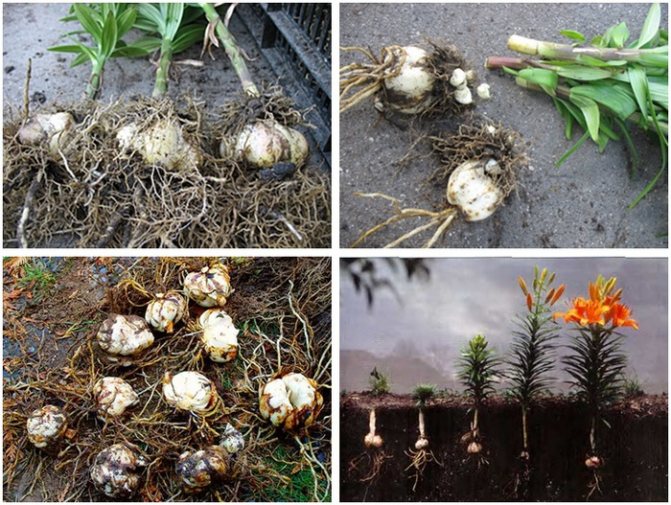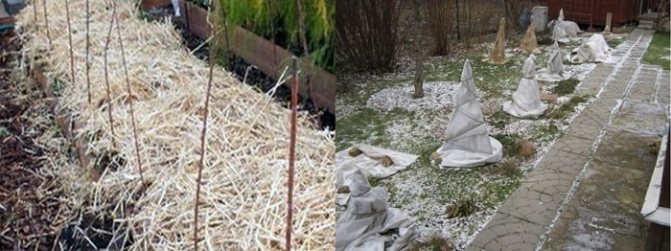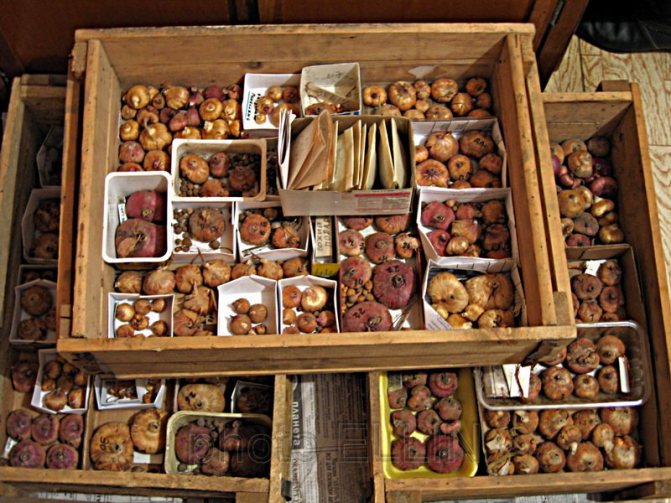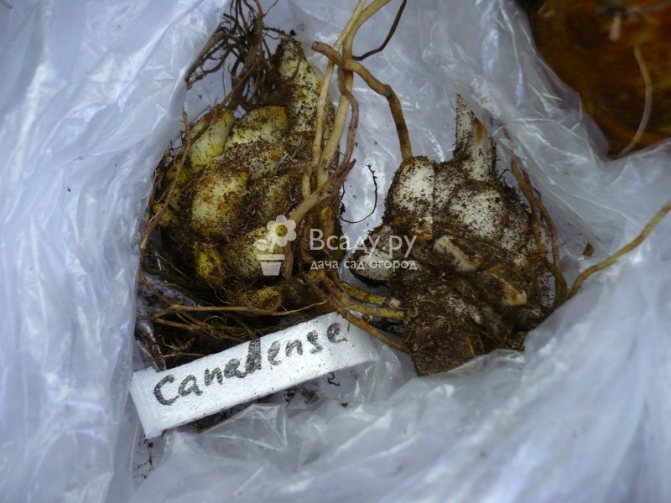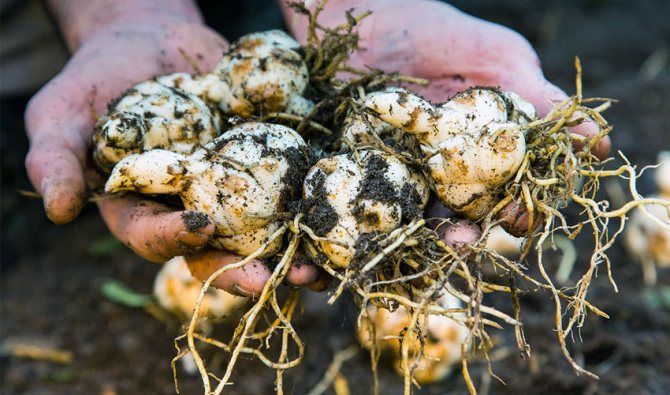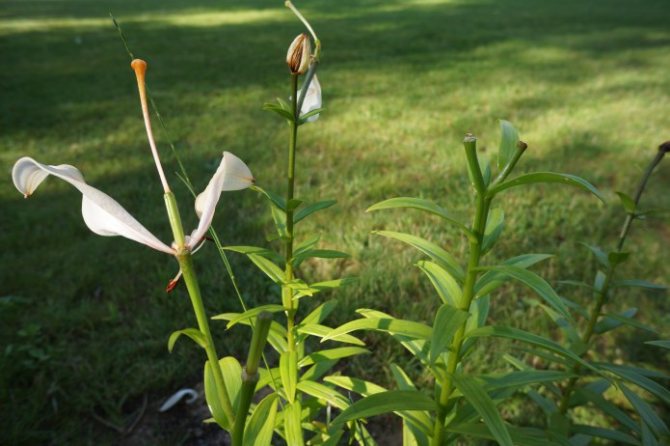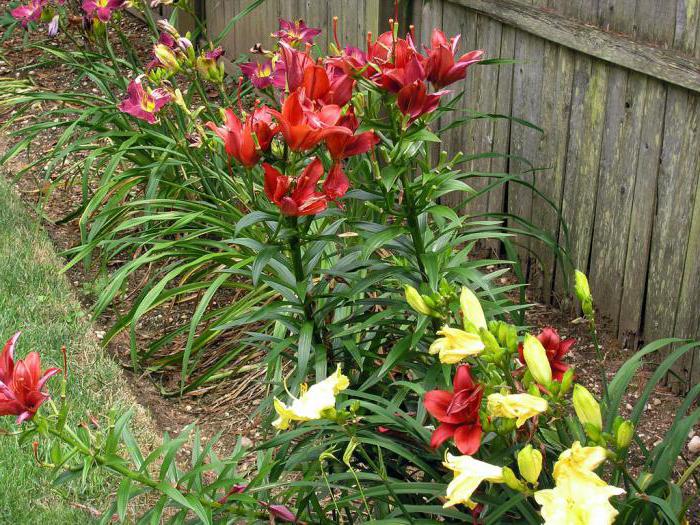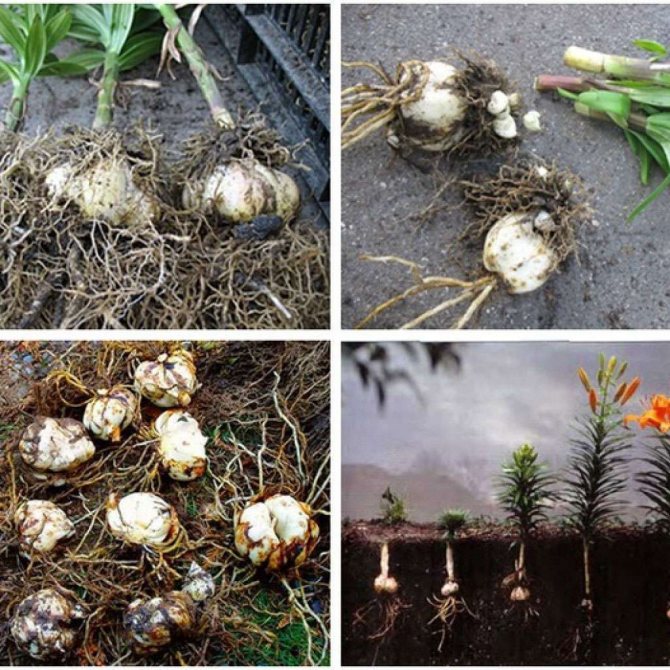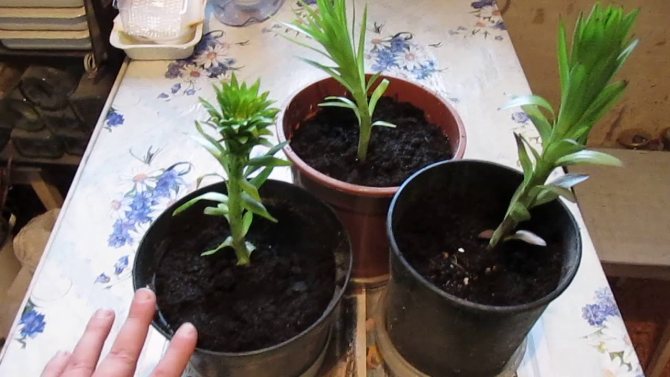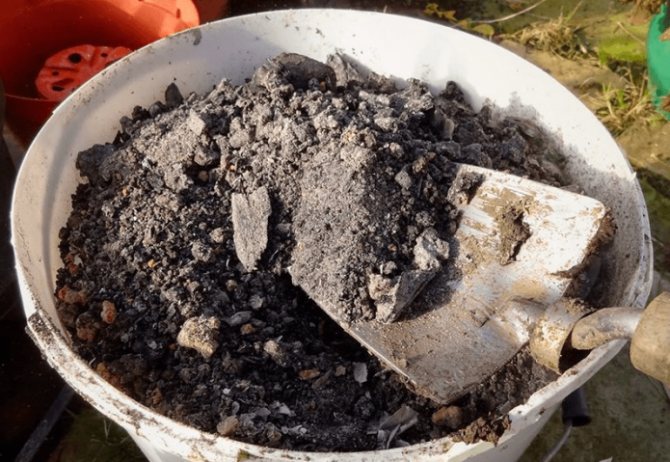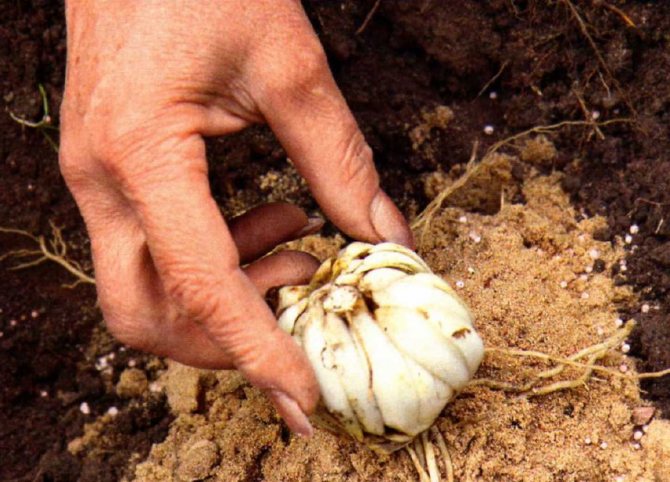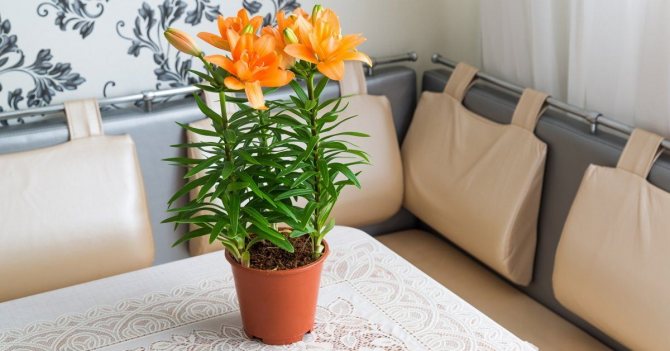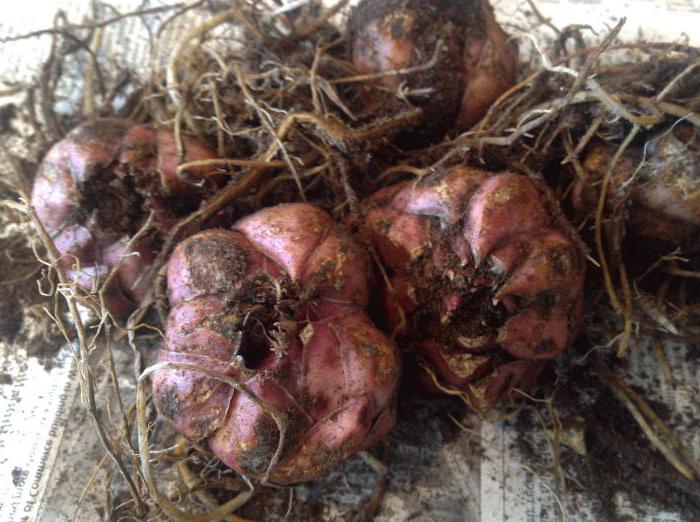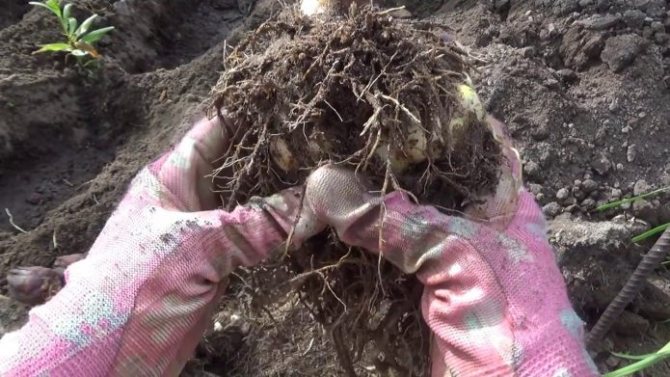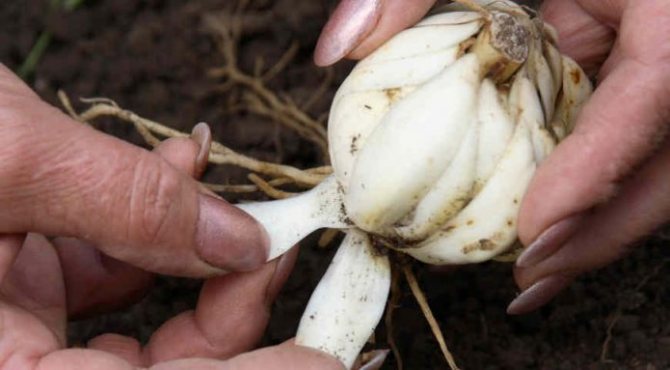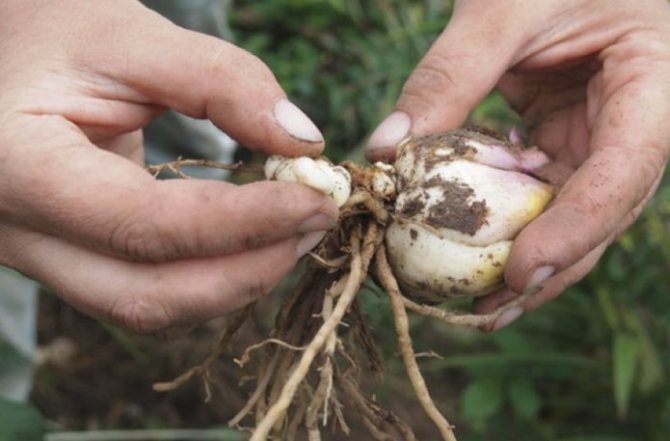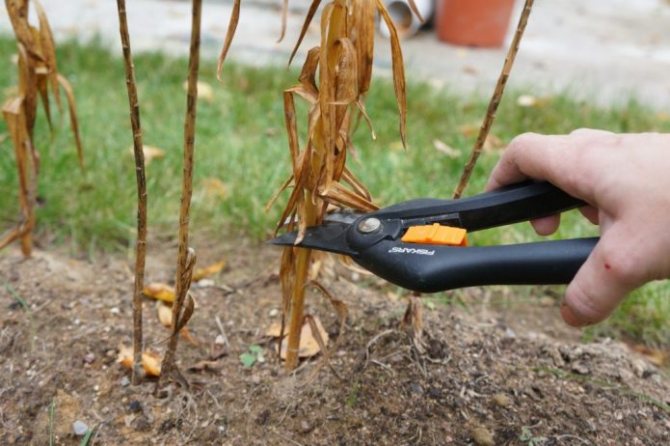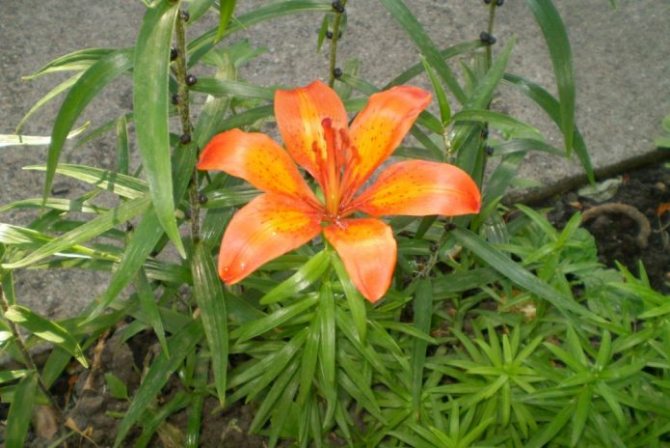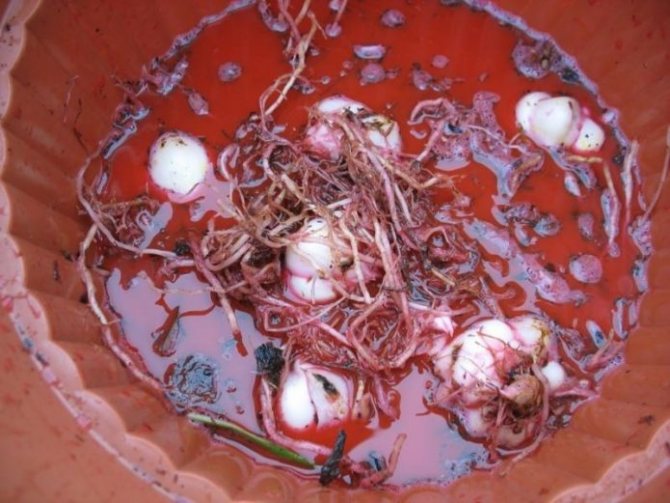Lily is undemanding to care, unpretentious in matters of cultivation. However, some varieties (oriental, American hybrids) are still not able to withstand the severe Russian frosts, as a result of which they stop blooming, often get sick and freeze out. Other varieties, on the contrary, easily adapt to the local climate and invariably delight with abundant flowering. One of the factors affecting the quality of growth and flowering is a competent approach to growing a flower, including the question of when to dig up lily bulbs and plant them in the ground.
Why do you need to regularly replant lilies
The first 3 years after planting, the lily is actively "settling" in its living space, it has enough nutrients from the surrounding soil, there is enough space for the bulb to develop, the growth stimulants caused by the stress of the previous transplant have not ended.
But after this time (and for some varieties, much earlier), such comfortable conditions for growth and development end.
Annual babies grow, taking space and nutrition from the mother plant. Old scales of the bulb become an obstacle to the full assimilation of nutrition. Fungi and pathogenic microbes accumulate in the soil. Lilies need to change their registration!
Is it necessary and why to dig up lilies for the winter
When to plant lilies
It all depends on the location of the site, namely on the climatic conditions of the area. If the winters are not very cold with a lot of rainfall, lilies can be left in the ground for the winter, providing them with good shelter. But even in this case, the plants must first be dug up and then rooted in the soil, thereby distributing the young tubers and removing the old ones.
Important! The procedure is carried out before the onset of the first persistent cold weather. It is better to dig up plants in dry warm weather during the day.
When can lilies be transplanted
To determine the optimal time, you need to understand the mechanism of development of lilies.
In the process of flowering, the bulb loses in weight and size, since it has given all its strength to a powerful peduncle and numerous flowers. The bulb needs time (at least 3-4 weeks) to recover and the corresponding conditions are:
- a sufficient earthen clod over the bulb;
- safety of leaf mass;
- removal of seed bolls.
The root system of a blooming lily develops mainly not under the bulb, but above it. Therefore, the planting depth is very important. It is:
- for lilies blooming in June - 15 cm of land;
- for late-flowering varieties - a shovel bayonet (about 30 cm).
Important! If the bulbs are planted shallowly, then after flowering, it is necessary to add fertile soil to the peduncle to ensure the nutrition of the supra-bulbous roots.
Through the leaves participating in photosynthesis, the bulb receives additional nutrition. The more the leaf mass is preserved, the larger the bulb will eventually grow.
Note! Only yellow leaf blades can be removed from a faded lily.
After the end of flowering and the fall of the petals, the seed pods begin to form in the lily. For their formation, the bulb spends additional forces. If lily propagation by seeds is not planned, these pods must be removed.The boxes can simply be broken off without removing the flower petiole, so as not to injure the peduncle shoot.
Remember! It is possible to dig up lilies for transplantation only after complete resuscitation of the bulb, when it has entered a dormant period. This happens no earlier than 1.0 - 1.5 months after the end of flowering.
You can transplant in the fall, a month before the onset of constant cold weather, and in the spring, and even in the summer. The exact timing of transplanting depends on the variety of lilies and the climate where the flower is grown.
What lilies can be transplanted in summer
Early flowering lilies, which finish flowering by mid-June, have a dormant period in July-early August. These plants can be replanted in summer. These include the Snow White lily or Candidum.
Transplanting lilies in the fall
The dormant period for lilies that have faded in July-August begins in September. They can be replanted in the fall. This period is convenient for carrying out parallel operations with a transplant:
- reproduction of lilies by children and scales;
- sanitizing the bulbs.
For the rooting of the bulb and its further normal wintering, 2 factors are necessary:
- Soil temperature when planting is not less than 12 degrees.
- No frost within 30 days of planting.
The timing of the transfer is determined by the weather conditions of the region:
- The middle zone of Russia is mid-September - the second decade of October;
- Northwest of the European part of the Russian Federation - September;
- Ural - from the first ten days of September to the first days of October;
- Siberia - August - September, when the cold has not yet come;
- North - no later than the end of August, and only zoned varieties.
If, according to the long-term forecast, winter is expected to be cold (temperatures below -25 degrees), then the transplanted lilies are covered with a 10-centimeter layer of sawdust, peat, leaves. Cover with spunbond or burlap on top.
Spring transplant of lilies
This transplant is considered the most troublesome, since the bulbs must be stored indoors during the winter. In addition, in dry and fast spring, bulbs may not receive the required amount of moisture from the soil.
However, due to various circumstances, sometimes this period is the only acceptable one.
A spring transplant is needed if:
- lily blooms in September-October;
- cold comes early;
- winters are consistently colder than -25 degrees and the bulbs in the ground will freeze, even if they are covered.
In defense of a spring transplant, it should be said that when planting in spring, lilies grow faster, get sick less and throw out more powerful flower stalks.
The main troubles of lilies are water and mice. Spring plantings are not flooded with melt and groundwater, they are spared from winter invasions of rodents.
Note! Spring lily transplant is poorly tolerated:
- Curly;
- Hanson;
- Snow white;
- Shovitsa;
- Canadian;
- one-brother.
If there is a need to transplant a lily in the spring, which has already begun to grow, then you need to remember that it is permissible to do this if the sprout is not higher than 10 cm.Otherwise, the plant will hurt for a long time.
Storing bulbs for spring transplanting
However, there are also disadvantages in the spring transplant associated with non-compliance with the rules for storing planting material:
- low humidity - bulbs can dry out;
- high humidity and lack of ventilation - the bulbs will rot;
- a disease that is not detected in time can spread to all planting material;
- high storage temperatures will cause the lily to grow too early.
In order to save the bulbs for spring planting, they must be dug up before the frost begins, no later than early October.
The bulbs are carefully cleaned from the ground, being careful not to damage the surface.
Important! To shake off the ground, it is unacceptable to tap the bulbs against each other or on any hard surface.
After removing the main part of the earth, the bulbs are disinfected for 30 minutes in a light pink solution of potassium permanganate or phytosporin.
Then they are removed from the solution, dried, examined for pest damage. Remove damaged and dry scales and place in a container with moss or sawdust to maintain constant moisture.
The storage container must be breathable!
Store the bulbs at a temperature of +4 degrees on a protected balcony or on the bottom shelf of the refrigerator.
Problems when growing indoor lilies
Often lilies refuse to release buds or their greens turn yellow and dry. This occurs not only due to illness, but also due to improper care. Common causes of problems are temperature drops, insufficiently moistened soil and air, lack of nutrition, inappropriate packaging, and lack of a dormant period.
Why does the indoor lily not bloom?
The buds may not appear for the following reasons:
- Lack of moisture in the ground, air. Care - water more often, spray the plant.
- Changes in temperature, which leads to rotting of the bulbs. Keeping lilies in a room with a constant mild climate will help to avoid this.
- Lack of light, fresh air. The solution is to move the lily to a well-ventilated area with bright, diffused light.
- Too wide a pot in which children grow, green mass. The solution is to transplant a lily into a smaller container.
- Lack of a dormant period. Leaving - move the pot to a cool, shaded place in the fall.
Why do lilies dry leaves
This problem is the most common. A change in the color of the foliage indicates the following:
- Autumn has come, so the yellowing of the greenery is natural. Caring for lilies at home is traditional - preparing for rest, keeping the flower in the cold.
- Damp foliage can be exposed to direct sunlight, causing burns. You need to move the pot to a room with diffused light, water or spray the plant in the evening or early morning.
- Dry air. Care - place a humidifier and a container of water next to the lilies. In addition, the flower pot can be placed on moistened stones, expanded clay, moss.
- Lack of nutrition leads to disruption of the process of photosynthesis, the suspension of the production of chlorophyll. When plants are actively developing, saturate them with complex compounds. When leaving, mixtures with a high content of potassium and iron are especially recommended: 2 tsp. citric acid + 7-9 g of ferrous sulfate + 3 liters of cool water.
Is it possible to transplant flowering lilies
Among the lilies, there are exceptions - Asian hybrid varieties that are transplanted at any time, even during flowering. These hybrids withstand the stress of transplanting and recover quickly from this operation.
It is only necessary to remember that these varieties are transplanted by the transshipment method, keeping the earthen lump. The main advantages of this method of transplanting are that, without injuring the root system, plants can receive nutrients from fresh soil at any period of their life cycle.
Further care
Lilies are planted in a watered flower bed the day before. They will not need to be watered anymore; when planting, the soil is mulched and left until spring. The same is with those bulbs that were left to winter in their place. While the autumn is dry, it is not required to close the plantings. With the onset of torrential rains, the flower bed is covered with spruce branches, peat and solid plastic wrap. This is especially true for hybrid varieties, which were originally bred for regions where autumn and winter are dry. Under such a warm and dry cover, the roots continue to grow for a very long time, as long as the soil temperature remains positive. Now you know how to preserve lilies after flowering, what to do so that next year the plants will delight with their beautiful appearance.
Place for transfer
In order for the bulb to receive a "push" to activate flower buds, it must provide the following conditions:
- sunny place protected from the wind;
- good drainage;
- loose, air-permeable soil with a neutral reaction.
If it is not possible to plant a lily in a new place with rested soil, you need to reclaim the site planned for planting. The area for planting is chosen at the rate of 20-25 cm in diameter for each bulb.
Transplanting indoor lilies
Domestic lilies are transplanted annually into containers with renewed soil, because the old soil is being depleted.
For regular flowering in indoor conditions, it is required to prepare bulbous plants for planting. In the fall, the root system is cleaned of soil, rinsed with running water, and sorted out. Small bulbs are placed in wooden blocks with soil and grown during the winter. You can transplant a room lily in late winter or early spring.
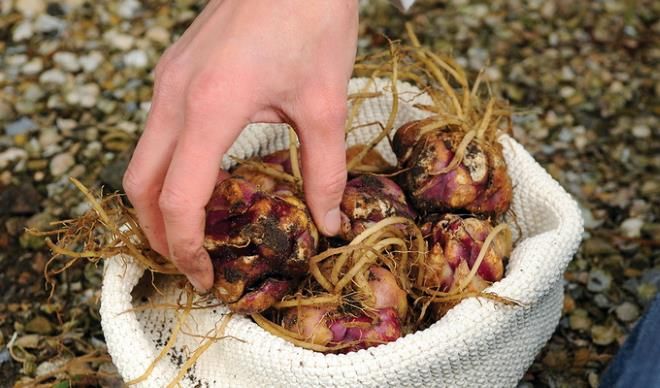
Indoor bulbous develop up to 5-6 years. Mature plants begin to bloom less often. The root system can be divided into several parts and a new Liliaceae shrub germinated.
Experts recommend separating the bulbs in late autumn to minimize plant trauma. The separated parts are placed in new containers.
Soil preparation
The soil for planting is dug to a depth of at least 40 cm, removing the roots of the weeds. For digging, make:
- peat;
- sand;
- superphosphate;
- potassium sulfate;
- soil deoxidizer (dolomite flour or wood ash).
For Asiatic lilies, which grow well in acidic soil, it is not necessary to reduce the acidity.
Note! Lilies cannot tolerate fresh manure, bird droppings and unripe compost. With the introduction of these compositions, the risk of fungal diseases and burns to the surface of the bulb increases.
Wintering in the ground
If a transplant is not required this year, the plants look healthy, then you can save the bush until September, only then cutting it off at the root. This will give the bulb the opportunity to gain strength and winter well. Pay attention to the condition of the bush: if in August it turned black, rotted or very dry, this may indicate a fungal disease. Then you need to dig up the onion, unscrew the stems from it, pickle in a solution of potassium permanganate, and then plant it again. The soil for lilies needs loose, light, permeable and nutritious soil. It should be prepared in advance, watering the day before.
Transplant procedure
After the transition of the plant to the dormant period (the leaves have withered, the peduncle wilted), you can start transplanting the lily.
Preparing the onion
The algorithm of actions is as follows:
- Dig up the bulbs (or the entire nest). It is safer to do this with a pitchfork, sticking them at a distance of 15-20 cm from the peduncle. It is better to remove more soil than to damage the bulbs.
- Clear from the ground.
- Rinse in cool water to make it easier to separate the bulbs from each other.
- Dismantle the nest into individual bulbs, carefully separating the roots.
- Unscrew the stem from each onion in a circular motion. If the bulb is fully ripe, then this operation takes place effortlessly. If the peduncle does not twist, you need to put the bulb on ripening for 7-10 days.
- Remove all dead, damaged and dried scales.
- Separate the kids. They need to be landed on a separate site.
- Trim broken and too long roots.
- Dip the onion in a disinfectant solution for 20-30 minutes.
Planting pit preparation
For the normal growth of lilies, it is important to plant them at the right depth.
Take note! Depth rule: 3 bulb heights. For "heavy" soils, it can be planted at a depth of 2.0 - 2.5 heights. Plants with abundant flowering can be planted at 4 times the depth.
A hole in the soil prepared and filled with fertilizers is prepared 15 cm deeper than is necessary based on the height of the bulb.
- Drainage (8-10 cm) is placed at the bottom of the pit: expanded clay, broken brick, pebbles.
- The next layer is garden or meadow land to completely close the drainage.
- Then river sand is poured in a slide. On top of this mound, bulbs are planted, straightening its roots.
- Top covered with fertile soil.
- Sprinkle abundantly with water, preferably 2 times. The second time - after the complete absorption of the first portion of moisture. After such watering, voids in the ground are guaranteed to disappear, and there is no need to trample the soil, risking damage to the bulbs.
- A layer of dry garden soil is poured over the damp earth. This is necessary to prevent the appearance of a crust after the soil has dried and to exclude weathering of fertile soil.
For heavy clay soils with a close groundwater approach, another planting method is used. It protects the bulbs from rot. This is especially true when growing expensive varietal lilies.
An onion wrapped in sphagnum moss is planted on a sandy mound inside the planting pit. Thanks to the bactericidal properties of this moss, the onion will be protected from any fungal infections. In addition, moisture-absorbing moss will absorb excess moisture.
Caring for indoor lilies during growth and flowering
Water the plants regularly, add nutrient mixtures. Basic rules for caring for lilies at home:
- Spray plants with cool, soft water, a growth stimulant, until buds appear. Do not fall on inflorescences. Shade the flowers after the procedure, otherwise burns may appear.
- When the plants are 9–12 cm tall, take them out onto the balcony. Get the flowers accustomed to the fresh air gradually. Start with 20-30 minutes of walking. Increase the hardening time by 30 minutes every day. At air temperatures below -12 degrees, it is not recommended to take out lilies.
- If there are many flowers on the bush, install a support.
Watering and spraying
All types of lilies need a lot of moisture. When the soil dries up, the flowers do not grow, they wither. To avoid this, water them every 3-4 days. Use boiled, settled, rain or melt water. Remember that after watering with hard water, a white bloom appears in the pot, which does not allow air to pass through. Salts will settle on the roots and prevent their growth.
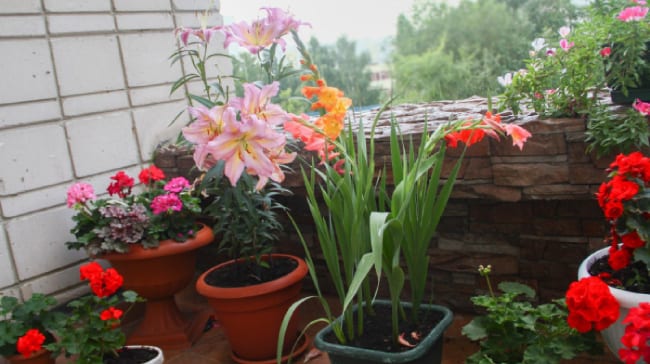

Lilies and other flowers on the balcony
Loosening and fertilizing
For better air and moisture permeability, loosen the soil to a depth of 4–6 cm, without touching the roots. Do this after every watering. Feed lilies with complex fertilizers for flowers - "Flower", from Bona Forte "For all indoor plants", "Good power", Pokon. Top dressing is recommended every 7-9 days. Also, stick to the following recharge schedule:
- After planting the bulbs.
- When releasing peduncles.
- After flowering, before wintering.
Disease and pest control
| Signs | The reasons | How to fight |
|
|
|
| Signs | The reasons | How to fight |
|
|
|
Mushroom mosquito, or sciarida
| Signs | The reasons | How to fight |
| Damp soil. |
|
Amaryllid or mealybugs
| Signs | The reasons | How to fight |
| Dry conditions. |
|
| Signs | The reasons | How to fight |
| Thin cobweb on foliage. | Dry air. |
|
| Signs | The reasons | How to fight |
| Buds, flowers with stripes, unevenly colored. |
|
Caring for transplanted lilies
Nursing operations will differ depending on the length of the transplant.
Spring transplant
In the spring, to stimulate growth, lilies need fertilization and abundant, but not excessive watering. Top dressing with a full complex fertilizer with a high nitrogen content will be optimal. For better air exchange, you should carefully loosen the soil around the plant, remove weeds and mulch the soil.
Summer transfer
The task of the grower when transplanting this period is to accelerate the survival of the bulb and the formation of new roots. During this period, it is important to feed the seedlings with phosphorus-potassium fertilizers with a minimum percentage of nitrogen, which provokes the growth of green mass. Several times it is necessary to process the planting with root-forming preparations.
Autumn transplant
For these plants, the main thing is to build up the root system and prepare for wintering. During this period, nitrogen is strictly prohibited. But fertilizers with a high content of phosphorus and potassium are shown. Within a week after transplanting, the bulbs are watered with root for better rooting.
When to buy a home lily
Experts recommend purchasing bulbs from late August to November. It is optimal to buy planting material at exhibitions and fairs of florists, in specialized departments. The purchase of bulbs is also common with the help of online stores, flower growers' forums, upon delivery, you need to make sure of the quality of the materials.
Buying bulbs
Inspection of the material is recommended upon purchase. Plants can only grow from good quality large bulbs. The scales should be aesthetic, not dry. Defects on the outer layer are not allowed.
Experts recommend refusing to purchase material that contains:
- deformed areas;
- spots;
- brown scales.
High-quality bulbs are characterized by a homogeneous texture, they are hard, smooth, heavy. Three-year-old bulbs are the best planting material.
Florists also buy bulbs with small leaves, shoots, buds. In this case, it is important to quickly plant a bush and fertilize the root system.
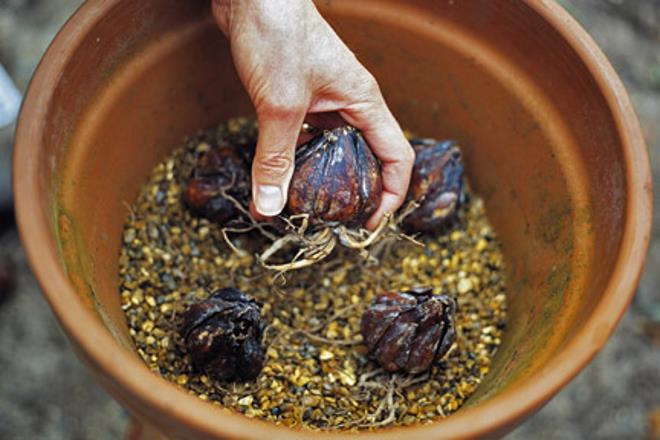

Summing up
Lilies are quite hardy flowers. For their comfortable development and abundant flowering, you need to know and fulfill several simple conditions:
- Transplant is a mandatory operation for lilies. The frequency of this operation depends on the type of flower.
- The transplant is carried out only during the rest period of the flower, which occurs a month after the end of flowering. The exception is Asian hybrid lilies, which can be transplanted at any time.
- The transplant time is chosen based on the climatic conditions and the variety of lilies.
- Depending on the time of transplantation, the flower needs its own care schedule.
Follow these rules, and the royal flower, according to legend, grew from drops of milk of the goddess Hera, the queen of the gods, will turn your flower bed into a piece of paradise!
In order to admire the beautiful lilies every year, after flowering, you need to give them due attention. In our article, we will tell you when to transplant lilies after flowering and what kind of care they need during this period.
Lily bulbs form many babies every year. Without leaving, their planting thickens over time, the flowers become smaller and lose their attractiveness. In order for the flowering to be plentiful every year, regular transplanting of lilies is necessary.
Watering
Although the lily in the country has already faded, and its leaves have begun to wither, watering the flower bed is nevertheless necessary. The bulb continues to grow and store nutrients, so a well-hydrated soil is essential.Of course, lilies need less water after flowering than during the active growing season. Water as needed, make sure that by the time of the next watering, the soil from above is dry.
There is no longer any need for foliar spraying, so this procedure can be neglected. After the final drying of the vegetative part, watering is completely stopped.
Pruning and feeding faded lilies
When the riot of colors of flowering lilies has died away, their bulbs begin to accumulate nutrients, preparing for wintering and the next flowering season. Food comes to them not only through the root system, but also through the green part - the stem, leaves. Even if the aerial part of the lily began to fade, it is still able to supply the bulb with the necessary substances.
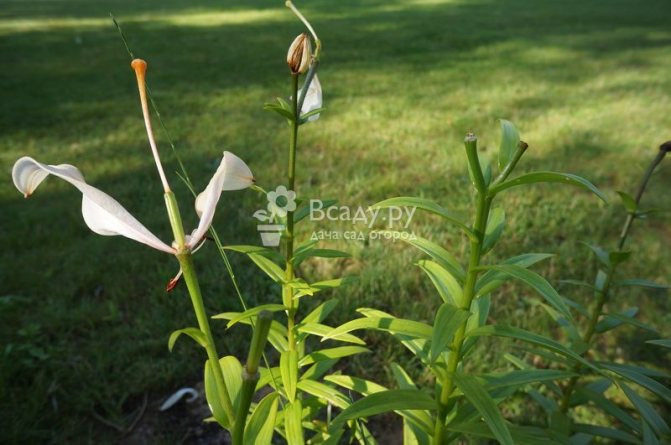

How to care for lilies after flowering
It is for this reason that the question of whether it is necessary to prune lilies after flowering, which arises among many gardeners, has a positive answer. Pruning of the green part of lilies is carried out in late autumn, when the bulbs are sleeping, or just before transplanting. Flowers are cut off immediately after they wilt, so that seed pods do not form, and the plant does not waste its energy on their development.
Feeding lilies after flowering with phosphorus-potassium fertilizers (Nitrofoska, Potassium monophosphate, Nitroammofoska) will help the bulbs gain strength before transplanting. Organic fertilizers can also be added.
Feeding lilies with organic matter
Lily bulbs do not have a protective shell and can get burned from concentrated organic matter, therefore, the fertilizing solution is made weak: 0.3-0.5 liters of slurry per 10 liters of water.
So that pruning lilies after flowering does not harm the bulbs, it is carried out after the stem has completely wilted. Cut off the dry part, leaving a stump of 10-15 cm. In late autumn, this stump is pulled out of the ground so that the cold does not pass through it to the bulb.


Pruning dried lily leaves
How to care for a house lily during the growing season
Growing lilies in pots requires proper care. For good growth and a long flowering period, the bush needs fertilization, maintaining the required humidity level in the room and watering. Experts recommend to loosen the soil next to the lily stems to a depth of no more than 5-6 cm to prevent damage to the roots. The procedure helps to provide an oxygen supply for the development of the root system.
When the stems reach a height of 10-12 cm, the plant is taken out to the loggia or to the front garden. However, a phased preliminary hardening of the flower is required. The lily pot is placed on the balcony for 0.5 hours. The time is extended every day by 10-15 minutes. When the temperature drops to a temperature of less than + 12 ° C, the flower is brought into the house. After a hardening period in summer and autumn, lilies are grown on the veranda.
Watering
Lily care includes mandatory watering. Flowers are moisture-loving varieties. With insufficient soil moisture and dry air, the flowering period may be delayed or not come. Stagnation of water in the container is not allowed; for this, soil drainage is performed.


The plant is watered with water at room temperature. Experts recommend determining the needs of the plant by the type of soil, not being guided by the watering schedule. The soil is moistened when its surface dries up. With dry air, it is required to spray the plant to prevent the leaves from drying out. Moisture should not get on the buds. Optimally keep the soil moist.
Fertilizer
Indoor Liliaceae require regular soil fertilization. It is necessary to feed the soil from the beginning of the growth of the stem. For lily varieties, manufacturers have developed complex feeding. However, you can combine the introduction of organic matter and mineralized complexes. Fertilization of the soil is carried out 3 times every 30 days before the formation of buds. During the flowering period, it is required to feed the plant once a month.
Lilies grow well when the soil is fertilized with potassium-phosphorus or nitrogenous substances. To accelerate growth, ash is poured into the soil.
Experts suggest observing the schedule for applying organic fertilizers:
- The first feeding is carried out after planting the bulbous, the procedure promotes the development of leaves, stems, ovaries.
- The next fertilizer is placed in the soil at the ovary of the peduncle until the flowering period. The introduction of the components contributes to the formation of buds.
- It is necessary to feed the plant in the second half of August to preserve the bulbs during the wintering period.
What lilies can be transplanted in summer
Snow-white lilies have different growing periods from other species, the care and transplantation of which is carried out in summer. The fact is that the bulbs of this species are at rest for a very short time - July-August. In September, they already begin to form a new rosette, and a transplant during this period will be very painful for them. The optimal interval for replanting snow-white lilies (lat.Lilium candidum) is once every 5 years.


Transplanting snow-white lilies in summer
Transplanting lilies during summer flowering is possible if Asian hybrids grow in your garden. You do not need to cut off the stem and roots, but it is better to cut off the buds and flowers so that all the forces of the lilies go to rapid rooting. The next year, the lilies will bloom profusely again. For the Asiatic lily, transplanting in autumn, spring and summer has an equally beneficial effect on further development.
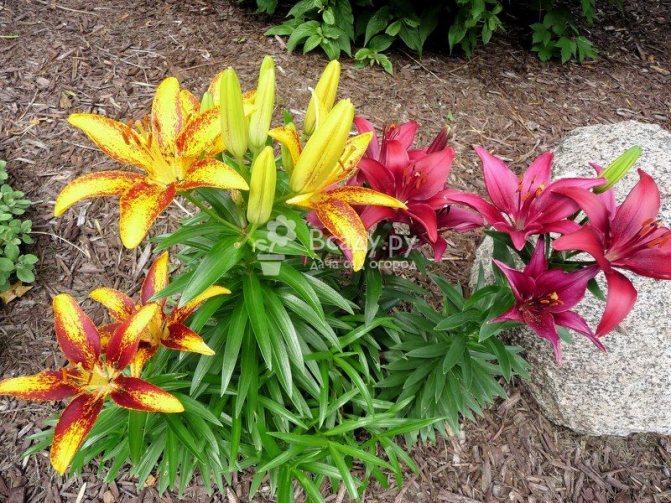

Asian lily hybrids can be transplanted even in summer during flowering.
The reasons for the lack of flowering and yellowing of foliage
In some cases, lilies in a pot may not bloom for a long time, the stems turn yellow during this period, slow down growth,
When deciding why the indoor lily does not bloom, possible reasons are taken into account:
- lack of a sufficient amount of trace elements, nutritional components, to stabilize growth, you will need to feed the plant;
- rare watering of the soil does not allow the formation of bud ovaries, contributes to a decrease in foliage growth;
- insufficient amount of fresh air for the plant or location in a darkened room, to prevent the leaves from wilting, the flower is placed closer to the light and the room is regularly ventilated;
- the lack of budding is possible when the bulbs are placed in a volumetric tub, in this case the plant begins to create new bulbs and does not release peduncles.
How to transplant lilies in the fall, after flowering
Transplanting lilies after flowering is an important step in caring for lily beds. It is held every three to four years. This spacing is considered optimal for most types of garden lilies, but there are exceptions to this rule.
Features of subspecies of lilies
American and curly lilies (Martagon) can grow for 10 or more years without transplanting and reducing flowering intensity. At the same time, Tubular and Asiatic lilies are required to be transplanted annually, at least in a year. Their bulbs grow intensively, forming many children.
Determining when to dig up lilies for transplanting is very simple - at least a month should pass from the moment the flowers wither. Early varieties blooming in July are dug out for transplantation no earlier than August, late ones - in September-October. Transplanting lilies early, when the bulbs have not yet ripened, will lead to painful adaptation of the plant, and sometimes even to its death. Late transplantation is also not desirable, since the bulbs unrooted in a new place may freeze out.
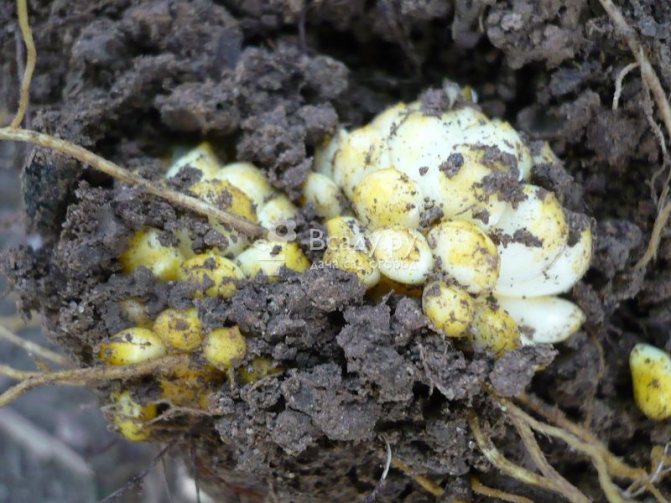

Digging up the lily bulbs after flowering
During the lily transplant, the bulbs are dug up and prepared as follows:
- The soil must be dry before digging;
- The soil is lifted with a shovel at a distance of 30 cm from the stem;
- Children are separated from the bulb and dead scales are removed;
- For 1-2 days, dry the bulbs in the shade;
- Before planting, it is advisable to treat the bulbs with one of the disinfectants: a pink solution of potassium permanganate, charcoal with tobacco dust, and the Maxim fungicide.
The bulbs are planted on the dug beds one by one or in groups. 5-10 g of superphosphate and river sand are added to each well. The planting depth of lily bulbs is 10-20 cm, depending on the size of the planting material. A more shallow transplant of lilies in the fall will lead to freezing of the bulbs, and too deep - to a delay in the appearance of the peduncle.
Lily transplant after flowering video
You can start transplanting after pruning and feeding the lily after flowering, a detailed video review will tell you what to do at this stage.
Growing lilies in the garden is not difficult. To prevent beautiful flowers from dying and not losing their decorative qualities during flowering, regular transplanting of bulbs is needed. Adhere to the recommendations, timing and frequency of transplanting lilies, depending on its variety and conditions of detention.
Proper care of lilies after flowering creates the prerequisites for the development of a bush that blooms profusely with beautiful large inflorescences. To do this, you should observe agrotechnical standards and take into account the peculiarities of the flower. So, the lilies have faded - what to do next with them?
Diseases and pests of domestic lily
Indoor lily is damaged by viral diseases, exposure to insect pests. The defeat of the fungus occurs from oversaturation of the soil with water and in insufficient lighting. If a plant is damaged by gray rot, it is necessary to cut off the damaged areas, the plant is sprayed with a spray bottle, processed with copper sulfate in a dissolved form.
Flower bulbs can be deformed from soft rot. Damage is indicated by the appearance of brown, moist spots on the surface of the bulbs. The planting material softens and becomes moldy. In case of partial damage, the rhizomes are treated with crushed coal and sulfur. The bulbs are placed in Rogor's solution for 1 hour, then dried.
If the lily is affected by the disease, the mosaic cannot be restored to the flower, the rhizomes are dug up and burned.
At elevated temperatures, lilies are affected by thrips and spider mites. The plant must be treated with soapy water and sprayed with insecticides.
How and when to prune lilies after flowering
One of the important things to do with lilies after they have faded is pruning. If the stems with faded inflorescences are cut off early, immediately after flowering, the development and growth of the bulb stops due to the cessation of photosynthesis in the ground part. A weakened plant can hardly tolerate winter cold and by the new season one should not expect high decorative effect from it.
Important! It is recommended to remove wilted peduncles from the bush, on which seed pods have begun to ripen.
You need to cut the stem with sharp tools: a knife, garden shears, which must be disinfected. So that moisture does not accumulate on the cut and conditions are not created for the development of pathogens, the cut is made obliquely.
Flower beds with withered lilies look unattractive. To increase their decorative effect, the drying inflorescences are closed by sowing rapidly developing annual flowers in front of the lily bushes: petunias, marigolds.
How to dig up lilies
Lilies (flowers)
As soon as the lilies have faded, their seed pods are removed, while the leaves and stems must be preserved, as they provide nutrition and the process of photosynthesis. When the time comes to dig up flowers, the ground part of the lily is cut off, the bulb is removed from the ground and the following actions are carried out:
- The soil is shaken off the bulbs.
- The stems are shortened, leaving 5-centimeter cuttings.
- The bulbs are checked for damage and decay and then thoroughly rinsed in clean water.
- Further within 30-40 minutes. they are kept in a special disinfection solution. It can be potassium permanganate or karbofos.
- Then the bulbs need to be dried. They are now fully prepared for storage.


Digging up lilies
Top dressing and other agrotechnical measures
The lily is systematically fed throughout the growing season. The flower needs additional dressing after flowering, when the bulb is formed. In the second half of summer, after flowering, the plant needs fertilizers with a high content of potassium and phosphorus. You can fertilize during this period:
- potassium monophosphate at the rate of 25-30 g / m²;
- potassium sulfate (10-15 g / m²);
- superphosphate (20-25 g / m²);
- wood ash (100-150 g / m²);
- humus (bucket for 1 m²);
- special dressings for bulbous crops.
Top dressing for lilies
It is better to feed the plant with a liquid composition, which is prepared according to the instructions for fertilization. It is better absorbed.
Important! You cannot feed lilies with manure or compost. From such dressings, burns and damage appear on the bulb. The root system becomes vulnerable to pathogens, and, as a rule, the plant dies. You should not feed with nitrogen-containing fertilizers - they slow down the formation of bulbs.
The owners of garden plots and summer cottages are interested in what to do next in the open field when the lilies have faded. To maintain vitality, you need to take care of the plant:
- watering, avoiding dryness of the earth;
- loosen the topsoil,
- remove weeds.
Fertilizing lilies when they have bloomed
It is recommended to feed lilies with exclusively balanced potassium-phosphorus fertilizers. You need to purchase them only in flower shops. Homemade unrefined mixture may contain pathogens and bacteria. Mineral fertilizers should be avoided, since against the background of their application, the plant becomes more exposed to the external environment.
Such lilies lack immunity to diseases of various etiologies. As a result, they do not tolerate winter well and may die. Can be fertilized with organic mixtures. Compost should be used with extreme caution in the care of Liliaceae. It is capable of burning the bulb and provoking the development of fungal diseases.


Fertilizing with compost
A complex of fertilization measures should be carried out in August. The mixture used is diluted in the right amount of water (according to the instructions) and the lily is poured abundantly. Top dressing ensures frost resistance of the bulb and the harmonious appearance of new shoots after wintering. If you plan to dig up the bulbs for the winter, then you should not water with this solution. In this case, the onions are soaked for 40 minutes in the prepared mixture just before planting.
It will also be interesting: Caring for lilies - growing in the garden in the open field ⚜
It's time to transplant lilies in the garden
There is no need to dig up and replant a flower growing in the garden every year. This is done every few years (depending on the type of lily, the period between transplants can be 4-6 years, and the length is 10 years). When to replant lilies after flowering? This time comes 4-6 weeks after the end of flowering. Usually this is August - early September. By the time the flower is removed from the ground, all the stems of the plant should naturally wither.
The following stages of work on transplanting a flower growing on the street can be distinguished:
- a few days before transplanting, cut off withered stems;
- the plant is dug up, and the bulb is carefully freed from the clod of earth;
- the bulb is examined and damaged areas, rotten or blackened scales are removed (a change in color indicates damage);
- children are separated from a large onion;
- all bulbs, children and mature, large, are dipped in a strong solution of potassium permanganate for 20 minutes for disinfection;
- the disinfected bulbs are dried in a shaded ventilated room for 2-3 hours;
- the processed bulbs are planted in a prepared place or placed in winter storage.
On a note! More often than once every 5 years, lilies are dug up for reproduction, due to their peculiarities (for example, lack of frost resistance), with a decrease in the size of inflorescences, and signs of a disease appear.
Landing rules
For planting lilies, a large pot of sufficient depth is required. The flower needs soil preparation, drainage. It is important to leave 3-4 cm of the height of the container unfilled. When the stems appear, it is required to add soil to the container.
After planting, the pot is placed in a place with cool air (a suitable temperature is no more than + 10 ° C). The flower needs regular watering. However, water should not be trapped in the ground, so the sump must be emptied of excess liquid.
When pulling the stems up to 10 cm, it is required to move the plant to a place with air heated to + 16 ° C. The room temperature can rise as the flower develops. From planting to flowering lilies take about 18-20 weeks.
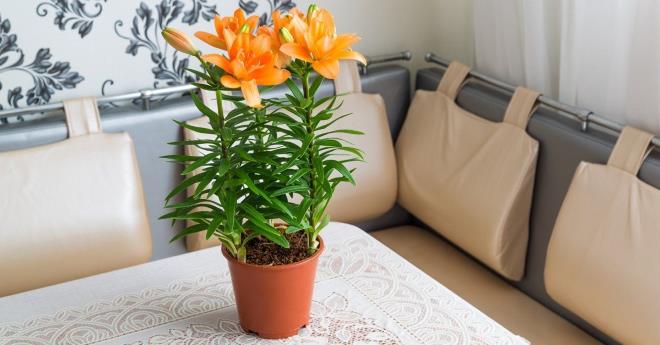

Preparing garden bulbs
It is necessary to dig up the bulbs in the fall (end of September - first half of October). Then the material is laid out in wooden boxes, the bottom of which is lined with sphagnum or peat. Storage is performed at temperatures above + 10 ° С. Moisturize the soil within 2 months. It is important to prevent stagnant water and to clean the sump regularly.
The composition of the soil for growing lilies
Potted lily is grown in specially prepared soil. The soil needs light, loose, filled with nutrients.
The soil contains the following ingredients (in proportions 3: 1: 1: 1):
- turf;
- leafy soil;
- humus;
- cleaned river sand.
To plant Liliaceae, you need to create a drainage layer. Optimal use of expanded clay, ceramics, sawdust, pebbles. At least 1/3 of the capacity is allocated to the drainage layer. It is not recommended to use bulky pots, because flowering period can be reduced. Drainage is laid in layers. In the greenhouse, you can plant bulbous varieties in a tub, decorative box or container.
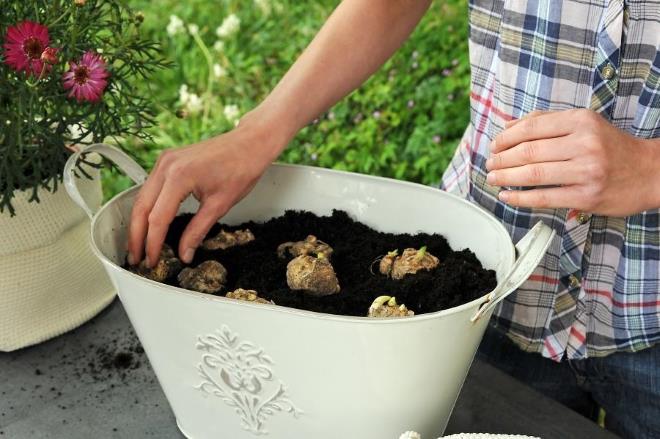

Protecting lilies in the open field from frost
Lilies planted overwintering in the open field need to create a shelter that will protect from frost. A layer of snow more than 10 cm thick saves from the cold weather. It is not worth hoping that the snow will fall before frost. It is better to help the flower overwinter and prevent freezing by sprinkling needles or foliage, peat on the place of its growth.
Note! If the winter has little snow, the ground of the flower garden can be additionally sprinkled with snow taken from other parts of the garden.
An important condition for the effectiveness of a shelter is to create it in time and remove it in time. If it is too early to remove the spruce legs scattered around the flower garden, to collect peat and foliage from the ground, then only the sprouts of the plant that have hatched can be damaged by frost. If the material protecting from frost is not removed for a long time, the plant will receive insufficient sunlight, the sprouts will hatch weak and thin. A flower bush will grow weak too.
Shelter lilies for the winter
Growing lilies at home
Plants are grown from seeds and bulbs. When using the first method, the bushes are less susceptible to diseases, insect pests. With proper home care, flowering occurs already in the second year after planting seeds.
How to grow a lily from seeds
Buy planting material or cook it yourself. The best time for sowing is March. If you chose February, then supplement the seedlings with a phytolamp. Landing is carried out as follows:
- Fill the box with fertile soil.
- Scatter the seeds over the ground. The distance between them is at least 1 cm.
- Pour a layer of sand on top.
- Water, cover the drawer with glass or a clear bag.
- Store the container where it is warm and dark. The air temperature should be 20-22 degrees. Make sure that the soil is always slightly damp.
- When sprouts appear, expose the box to light, away from direct sunlight. For full development, there should be 12-hour daylight hours.
- After 2-3 leaves appear, open the bulbs.
If lilies are houseplants
Many owners of houses, dachas, apartments, grow a flower indoors. They are interested in when the room lilies have faded - what to do with them next. The processes that the indoor lily undergoes are similar to the changes in the lily plants growing in their natural environment. Domestic flowers also turn yellow and dry out - first, their peduncles fall off, then the stems turn yellow and dry out. It is not necessary to touch the plant when it has just begun to fade. During this period, peace and the correct balance of moisture intake are important for him. Need to:
- reduce soil moisture by increasing the interval between watering to 6-8 days;
- stop spraying with water.
So it is possible to reduce the activity of processes in the ground part of the plant and to activate the processes occurring in the bulb.
When the ground part of the lily dries up naturally, watering stops altogether. The onion is dug up, cleaned from the ground and washed with water. Small bulbs are placed in seedling containers with moistened soil. During the winter, they will gain strength, and in the spring they can be planted in a garden or in a container for indoor plants to grow at home.
Bulb processing
Large bulbs are carefully examined, damage is removed from them, and the cut site is treated with crushed activated or charcoal. The stem that has not separated from the bulb is cut off, leaving a part of it up to 6 cm long on the bulb.For disinfection, the bulbs are placed for 25-40 minutes in a solution of potassium permanganate or a fungicidal composition, dried on paper or cloth, and then placed in a cold place in a bag (refrigerator, unheated cellar) until late February - early March. In early spring, the bulbs stored in the cold are removed and planted in a container filled with fertile soil.
Note! Transplanting indoor lilies is done annually and each time in a new soil.
Storing the bulbs
Autumn is the time to plant bulbs in containers for winter storage. It is not necessary to plant mature large bulbs. During storage, they can be placed in a box and sprinkled with a mixture of sand, peat, sawdust. Or fold it into a plastic bag and sprinkle with the same mixture. Or make boxes and put them on them, and cover them with moss and burlap on top. Bulbs stored without soil must be dried.
Then containers for the entire storage period are placed in an unheated cellar or on the lower shelf of the refrigerator.
Important! For small bulbs, planting in the ground for winter storage is mandatory - insufficiently strong onion children can dry out without soil. Planting them in the ground for winter storage is carried out no later than a week after digging up the lily bush.
Lily transplant
Lily can be transplanted in spring and autumn. Many growers prefer an autumn transplant - bulbs that are at rest at this time tolerate it well. In addition, in the fall, you can combine digging out the bulbs for storage and replanting. And the plants in the daylily can have different care requirements:
- varieties of Oriental and Orleans lilies requiring annual replanting;
- slowly growing varieties needing transplanting every 5-6 years;
- American hybrid varieties with a recommendation to replant every 10 years.
In order for a summer cottage with a daylily to look attractive, flowers must be transplanted correctly:
A week before transplanting, the shoots of the flower are cut off so that only a stump remains.
The plant is dug up, cleaned from the ground and examined. If there are damaged areas on the bulb (with dark spots, traces of rot), they are cut off.
Important! The tubers are washed in 2 waters and treated in a disinfectant solution of karbofos (1 tbsp per bucket of water) and left for 30 minutes in a weak solution of potassium permanganate.
The bulbs, wet after processing, are dried in a dark place at a temperature of 15-18 ° C, placing them on a wire rack on a tray.
Bulbs that have passed all stages can be planted or prepared for winter storage.
Indoor or house lily. care and cultivation. Practical advice
For cultivation at home, varieties of lilies are used, suitable for development in pots, boxes, on racks. The plant stretches up to 0.4-1.5 m. The stems are dense, dark green in color, the leaves are large, elongated. The shades of the buds range from monochrome to bright, combining several contrasting colors.
During the flowering period of the lily, an illuminated space is needed.
Regular spraying of the bush is required. In winter, the temperature for the plant can be maintained at + 16 ° C.
Types and varieties of room lilies
The house lily is grown by breeders in over 300 varieties. Varieties for planting in greenhouses and houses differ in the configuration of the buds, stem height, and care requirements.
Flower varieties are divided into subgroups:
Cup-shaped lilies have buds with wide-open petals. The subspecies include the names of the varieties Grand Commander, Gilded Lily, Empress of China, etc.
Funnel-shaped cultivars have buds with petals rolled into a tube. The variety combines the Regal lily, Royal Gold, as well as hybrid species with bud color in lemon, pink, milky shades.


Hybrid varieties are designed for growing at home. Asian, Taiwanese, Oriental hybrids are in demand. Asian lilies are distinguished by voluminous buds, curved petals covered with specks, thin stripes, the variety has no aroma. Taiwan lilies of small height (40 cm) with large buds of bright color. La hybrids are also widespread.
Variety selection
Classic lilies are intended for cultivation in flower beds, front gardens. For home cultivation, hybrid varieties of lilies Lovely, Golden, Royal are recommended. In greenhouses, a white lily is also bred, exuding a rich aroma, the plant reaches a height of 15 cm.
Tubular and goblet flowers with white petals interspersed with red, golden, brown colors are suitable for cultivation in rooms. At home, you can also breed terry varieties. Optimal cultivation on the windowsill of unpretentious tiger varieties that differ in their original color.
How to determine the type of lilies on the bulb
Different varieties of lilies require the implementation of recommendations for care, soil selection, level of illumination and watering. The type of lily can be identified by the appearance of the bulb.
White bulbs are of Asiatic lilies, LA hybrid varieties. Varieties need slightly acidic soil, fertilized with ash.
Oriental plants have bulbs with a loose texture, combining several shades (pale pink, golden, purple). Sorts pick up oxidized soil, the introduction of ash is prohibited.
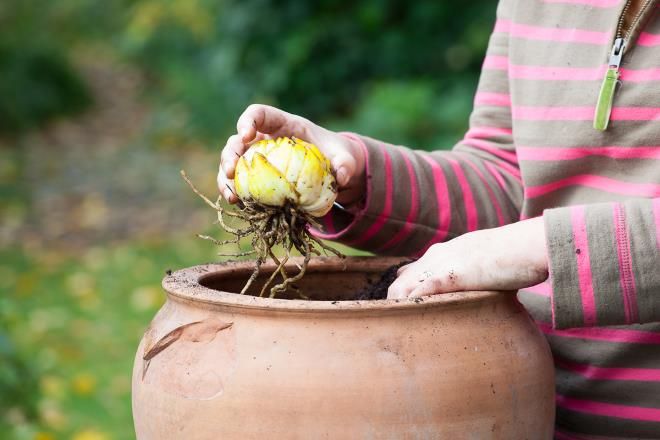

Bulbs of tubular varieties, which develop on soil with the addition of lime, have a purple hue.
Pinkish, golden bulbs in hybrid varieties (dwarf lily, beautiful lily), intended for growing on a balcony or street.
Bulbs of the same variety are placed in a tub. For a one-time flowering of bushes, the bulbs must match in size.
Reproduction by children
The most common and easiest way to propagate lilies is by root bulb propagation. In a lily dug out after flowering (approximately in August), daughter bulbs are separated from the root and planted in a box for growing seedlings or on ridges, deepening by 4-5 cm.If the flower planting site is a street, the ridge is covered with peat, autumn foliage, cover with a spruce tree.
Additional Information. Daughter bulbs in the beds and in the seedling box can be planted close enough to each other. The thickened plants in spring or autumn will be planted in their permanent growing areas.
After 2-3 years, adult bulbs are formed from the root bulbs, and the lily begins to bloom
Domestic lily and its varieties
The perennial culture is distinguished by a fleshy stem, has a different arrangement of foliage. The greens can be harvested near the bulb or evenly spread over the stem. The main advantage of the plant is its large flowers of 6 petals with a rich aroma.
There are many types of lilies suitable for home care:
- Citronella, "Dwarf" - height up to 60 cm, flowers have small bent petals with a diameter of 5 cm.
- Royal Gold, "Domashnyaya", "Long-flowered", "Regal" - funnel-shaped flowers.
- "Taiwanese", "Miss Rio", "Garden Party" are ideal for home conditions. They have compact bushes up to 40 cm high, large flowers.
- "Asian" - practically odorless, large flowers with spots, stripes, dots.
- Grand Commander, "Beautiful", "Gilded", "Empress of China" - flower bowls.


Types of lilies
Propagation by cuttings
Another easy way to propagate lilies after flowering is by cuttings. You can use a leaf with a stem piece or just a leaf, a part of the stem with a dormant bud. To obtain cuttings, the stem is divided into parts with 5-7 leaves, the lower ones are removed, leaving 2-3 upper ones on the cutting. A leaf for grafting is taken at the top of the stem.
The prepared parts of the plant are treated with a solution of a growth stimulant, keeping in it for up to 12 hours. Then they are planted in prepared containers filled with a fertile substrate.
Note! All summer is suitable for propagation by cuttings, especially July, when the plant is in the budding or flowering period. The cuttings obtained at this time have a greater vigor of growth, are distinguished by better survival rates.
Leaves and cuttings to the middle of their length are deepened, slightly tilted, into the fertile black earth and covered with cellophane or covered with a glass jar. Water regularly, ventilate every day, lifting a film or jar. Remove the moisture droplets from the covering material before returning it to its place.
After 1-2 months, the parts of the plant buried in the ground take root, and young leaves begin to grow from the formed bulbs. The cuttings that have gone into growth are planted in separate containers and grown until spring. In the spring, seedlings are planted in open ground.
Lilies obtained by stem cuttings can bloom already in the first or second year of planting.
Spring cuttings
You can propagate a flower by stem cuttings in the spring with planting in open ground. The plant is dug up in the spring, the stems are separated and planted in a greenhouse.
For 1.5-2 months, small bulbs grow on the end of the stem buried in the ground.
Additional Information. To increase the number of bulbs on the cuttings, several shallow longitudinal cuts are made on the stem before diving into the ground. This activates the growth of bulbs, their number can be about 40 pieces.
The rules for caring for lilies are simple and straightforward. Their performance largely depends on how the daylily near the house or an indoor flower will look. And every grower is interested in healthy, beautiful plants.
How to provide lilies with a dormant period during the winter season
Indoor lilies slow down development in the autumn, the leaves turn yellow, the plant stops growing. During the rest period, the flower is kept at + 5 ° C in a shaded space, the sun's rays are unacceptable. It is required to reduce watering, the soil is moistened when the soil dries. By the spring period, the pot is placed on the windowsill and the regularity of soil moisture is increased.
Bulky bulbs, after inspection for rot and deformation, must be placed in a dissolved potassium permanganate for 0.5 hours, then put on a cotton cloth and dried.
After pruning, damaged bulbs must be disinfected and treated with ash or charcoal.
The prepared material is placed in a place with a temperature of about + 5 ° C.
Literally "lily" is translated as "white-white". The flower symbolizes divine beauty, strength, power. Previously, plants were used to decorate royal clothing and palaces. Today lilies are one of the main decorations of gardens, apartments, they are successfully grown at home.
Possible problems
What to do if any problems are found when examining the stored bulbs?
- If you suspect fusarium, the tubers are immediately removed from the common storage area. All damaged scales are removed. The lily bulb itself is soaked in a fungicide solution. Then they are dried and placed again in a storage space, but already separately from the rest of the planting material. These tubers need special attention.
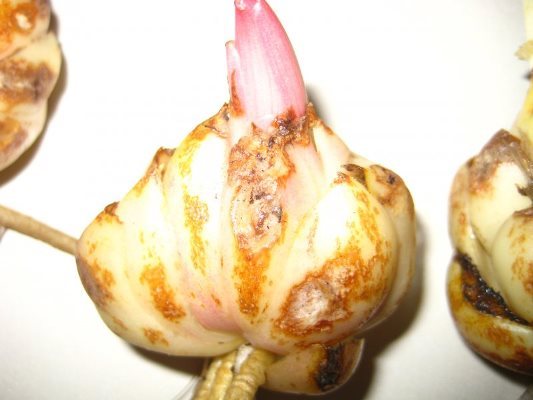

- If mold appears on the lilies, then it is removed with a cloth dipped in a bright solution of potassium manganese. Most often it is superficial. In the case when the spores have penetrated into the tissues of the plant, the affected scales are separated, the tubers are treated with potassium permanganate and dried. Store them, again, should be separate from the rest of the planting material.
- Another trouble awaiting flower growers in winter is sprouted tubers. Most often, a nuisance occurs when the temperature regime is not observed. The bulbs will have to be planted. Those that are smaller - in peat cups, large ones - in flowerpots or deep containers. If possible, containers with lilies are transferred to a cool room.
To keep the planting material healthy throughout the winter, it is important to store it at a temperature of about 1-5 degrees and an air humidity of at least 60% and no higher than 75%.
.
Leave the bulbs in the soil
Many gardeners leave lilies in the soil for the winter in the same place. For high-quality storage, 10-15 cm of snowfall is enough, and in the case of a snowless winter, the plant must be covered with a leaf or coniferous composition, spruce branches, peat collection. It is better to use a coniferous covering, which closer to spring will not attract pests. With the onset of spring, when the soil has thawed, the cover must be removed before the sprouts appear. This method is suitable for frost-resistant varieties.
If oriental varieties and oriental trumpet hybrids winter in the soil, then they should be under snow in dry soil. Therefore, in the first week of September, it is necessary to cover the planting area with polyethylene, and remove it with the onset of frost.
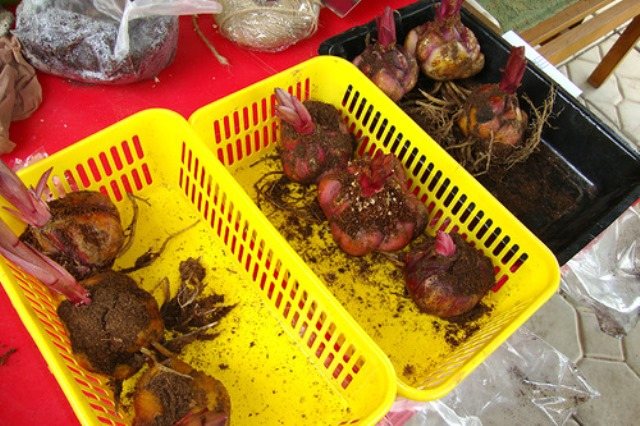

Storage of bulbs in boxes in the cellar
In what conditions to store
Lily bulbs should not be stored in a place that is too dry so that the planting material does not shrivel from excessive drying out. But the high level of humidity is not suitable for storing lilies. In damp places, they quickly deteriorate due to the formation of mold and premature germination.
The storage temperature of lily bulbs in winter is 0 ° C - + 5 ° C. At the same time, they should be in a ventilated place, closed from sunlight, which promotes their germination.
The condition of the planting material must be checked regularly. If mold begins to form on it, each bulb is wiped with a damp cloth, after which they are treated with a special charcoal powder.
Rotten areas of the bulbs can be cut off with a knife, and then treated with brilliant green. Too damaged material should be discarded.
How to store bulbs correctly
Instructions for digging lilies:
- Use a fork to remove the bulbs from the soil.
- Cut the shoots so that they are no more than 5 cm long.
- Shake the bulbs to remove excess soil from the roots.
- Trim the roots so that they are at least 5 cm long, but no more than 10 cm.
- Cut out all diseased and damaged roots: they will act as a source of infection.
- Rinse the bulbs in water.
- Disinfect them in a 0.2% Fundazole solution or in a dark solution of potassium permanganate.
- Dry the bulbs in a dark, well-ventilated place.
- Send them for winter storage.
Provide optimal storage conditions to keep your bulbs until next spring. For this:
- Prepare a plastic bag and lightly dampened sawdust.
- Make some ventilation holes in the bag. They are needed so that the bulbs do not stubbornly and do not start to rot.
- Place the bulbs in rows in a bag, sprinkling them with a layer of sawdust.
- Send the bag of bulbs to a place where they will be stored throughout the winter.
The room in which the lilies will be stored should have moderately humid air (50-60%).
The choice of a site for planting and the sequence of work
Lilies thrive in light and permeable areas, preferring nutritious soil, sunny, draft-free or light shade. Avoid planting lilies in the lowlands or in the shade of trees and shrubs. Their shoots are stretched and thinned, flowering comes later and not so luxurious.
Many gardeners allocate a special place in flower beds to lilies. They are so diverse, beautiful and graceful that they will win the heart of any grower. There are a huge number of shapes in different sizes and colors. Tall and low, smooth and terry, - lilies are suitable for any flower bed. When lilies are blooming in the garden, it is so good to sit next to them in the evening, inhaling the captivating aroma! But time passes, and the plants begin to dry out. How to care for lilies after flowering, so that they continue to delight the eye for many years, read below.
Storage conditions
How to keep lily bulbs until spring? It is important to remember that the following conditions are met:
- The storage area should be ventilated to prevent mold and mildew growth.
- The humidity should not be high as the bulbs will then germinate or rot.
- The air should not be dry as the bulbs will shrink and lose moisture.
- It is important to maintain the optimum temperature.
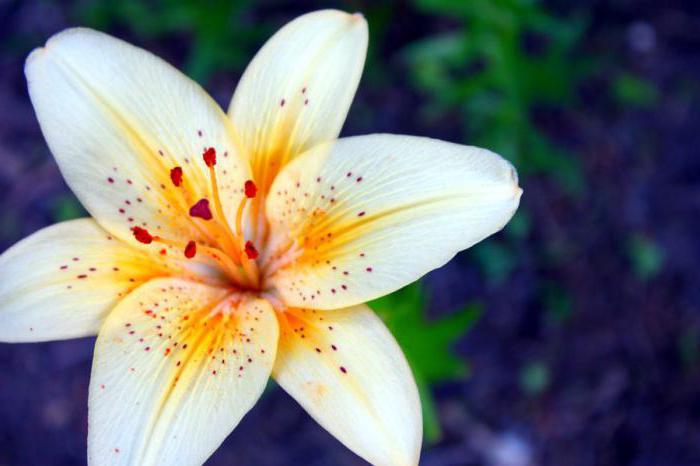

When to dig the bulbs and plant
It is not recommended to dig up lilies every year. It is better to divide the formed bulbs every 4-5 years. Since not all types of flower can withstand the Russian cold, lilies are usually dug up and stored until spring. If the climate in the region is mild, it will be enough to cover the flowers for the winter. If there is still a risk of losing the plant, it is better to play it safe and place the bulbs in the basement or in the refrigerator.
Note! Tubular lilies are dug up in any case, since even the most reliable shelter will not save the plant from freezing.
When to dig up lily bulbs depends on the particular flower variety. For example, LA hybrids are removed from the soil in mid-August, OT hybrids at the end, and Eastern and American hybrids at the beginning of September.
In addition, the following signs will help determine the right moment to dig up the bulbs:
- the flowering of lilies ended long ago;
- foliage has turned yellow or wilted.
If these phenomena are not recorded by the end of September, then all flowers should be dug out for storage for the winter.
For most varieties, the procedure is carried out at the end of August - mid-September.
Important! Some varieties of lilies can be transplanted even in summer. In this case, the question arises when they should be dug up: during flowering or after its completion. The first option requires special care, since it is important not to damage the lily flowers during transplantation, and also to provide the plant with abundant watering.
When to dig up a bulb after the lily has faded
Different varieties of lilies need to be dug out at different times. You must wait until the bulbs are ripe: mature planting material keeps well throughout the winter. Here are the signs that signal that it's time to dig:
- the flowering of lilies ended long ago;
- the stems and leaves of the plants turned yellow;
- the aboveground part of the plant wilted completely.
Gardeners recommend digging out LA hybrids and Asian varieties in mid-August. And in the last days of this month, you need to dig up OT hybrids.Oriental varieties are best extracted from the soil with the onset of the first days of September.
Important! All lilies must be dug up no later than the last days of September. Otherwise, the bulbs will not store well.
When to plant lily bulbs
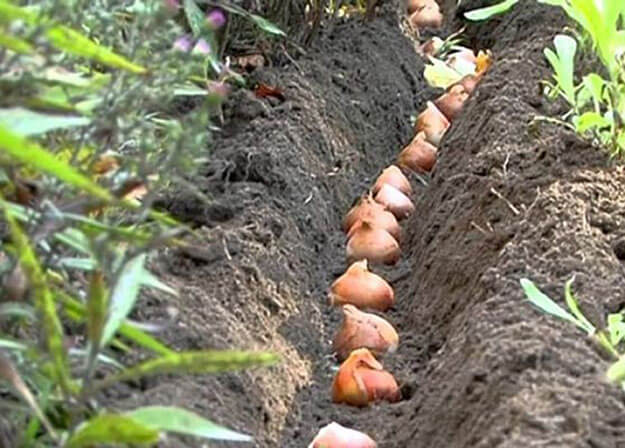

Lily can be planted:
- In the springwhen the spring frosts stop. This is the best time for lilies that cannot tolerate wintering outdoors.
- In autumn (beginning of September). This is the optimal time for planting varieties of lilies that tolerate winter well while in the soil. You can plant the bulbs in the spring, but then flowering will come later compared to those flowers that managed to take root in the fall.
- In summer... "Asians" can be planted at any time of the year, even during flowering. Of course, it is better not to touch flowering plants. But if there is an urgent need, it can be done. Other varieties of flowers cannot be transplanted during the formation and blooming of buds: they will die from stress.
Not all varieties of lilies need digging for the winter. Hybrids that are particularly winter-hardy can be left outdoors. Dug up bulbs need to be properly prepared before storing them. They also need to provide special conditions that prevent the growth of rot and drying out of the planting material.
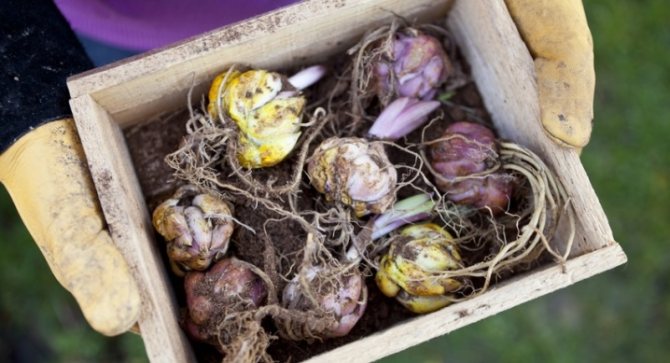

Lily was the emblem of the French kings, the flower inspired the work of poets and artists, its name served as the choice of a female name. Lily has more than 80 species, some of them, as a rule, are the most beautiful, are quite capricious and taking care of them requires some knowledge and patience.
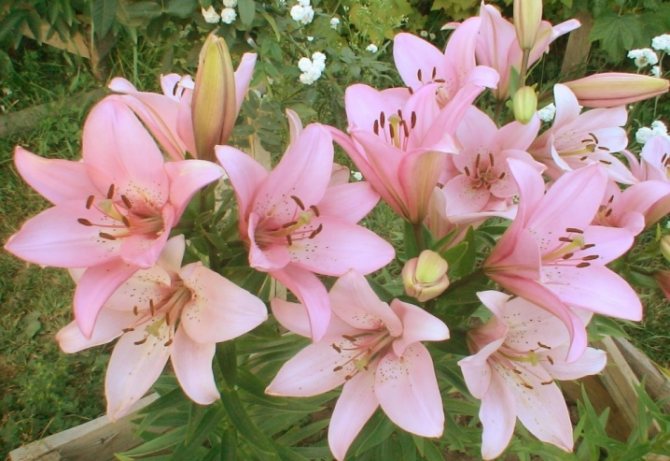

When to dig up lily bulbs for transplant
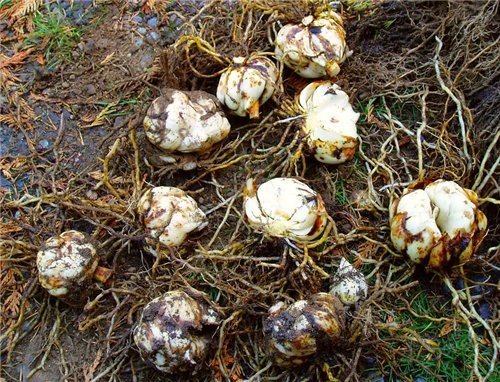

Let's figure out when you can dig up lilies for their reproduction and planting in a new place. The opinions of gardeners differ here. There are two main periods that are most suitable for transplanting bulbous plants:
- Fall... The optimal time for the middle region of Russia is mid-September (in the north - late August, in the south - early October). At this time, the bulbs had already managed to stock up on nutrients in order to grow new shoots for the next year. And after the transplant, there will still be time for the rooting of the planting material. If you do this later, the bulbs will not take root and will die in winter. If they are dug up late, it is better to store them until spring.
- Spring... The optimal time is when the return frosts are over. For the middle regions of Russia it is the end of May, for the northern regions - the beginning of June, for the southern regions - the beginning of May. In this case, plant the bulbs immediately after digging and processing them.
Attention! Some types of lilies, for example, "Asian", can be removed from the ground at any time of the year. They perfectly tolerate transplanting even during flowering.
Basic rules for storing lilies
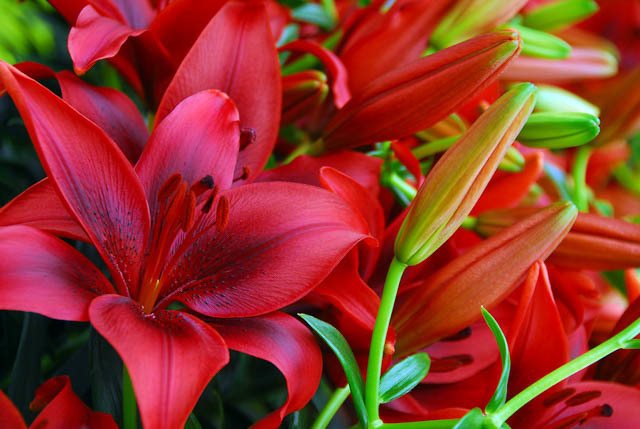

Experienced gardeners use a variety of storage options when growing flowers. Some prefer a refrigerator, others place the bulbs in peat-filled boxes or under snow. Everyone chooses a suitable method.
But when storing lilies, it is necessary to provide the necessary conditions:
- the location should be moderately humid; if the air is too dry, the lilies will begin to dry, and if the humidity is high, they will rot;
- the air temperature should be moderate (at a high value, they germinate early, at a low value, they sprout late);
- so that the culture does not become moldy and sick, you need to take care of good ventilation.
Shelter of lilies for overwintering
Sometimes you need to do more than just preserve the lily bulbs that were dug up with your own hands. There are times when the planting material was purchased before winter, and it needs to be saved. It is recommended to cover oriental hybrids of different varieties of representatives of the Liliaceae family. To do this, you need to make a trench in the garden area. You need to choose a place for it, where it is dry and sunny in spring, and a lot of snow lingers in winter.Good drainage will help avoid stagnant water in the trench. Lay out the trench with boards, make a cover.
Put lily bulbs in bags, pack, put in a trench, transferring bags with water. They will be an excellent indicator of temperature, maintain atmospheric drops. If the water freezes in the frost, then the bulbs will begin to freeze too. The storage is first covered with a film, then closed with a lid. On top, you can add a layer of cardboard, sprinkle with earth, cover with coniferous branches. To protect the material from mice, it is necessary to spread the rodent poison in the trench.
Description
The lily is a beautiful flower. There are 80 plant species and many hybrids. The flowers are large in size and in various colors. Some have a strong aroma. In shape, the flowers are divided into umbrella-shaped and funnel-shaped. Each of them has 6 petals and pronounced stamens. The leaves of the plant are usually straight.
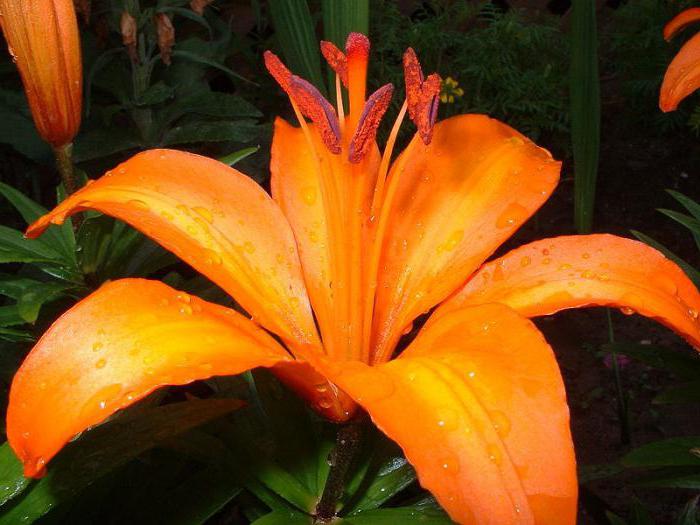

Flowers look great in bouquets, they perfectly decorate garden plots and apartments. The planting material, thanks to which the plant is obtained, is the bulb. It is rounded, large, with a sharp top. Each bulb has scales, shells. The pith includes the bud from which the stem develops.
Lily is grown from rounded bulbs. The color depends on the species, it is white, yellow, brown, dark purple. The leaves are evenly spaced along the stem and in the leaf axils.
Important rules for pruning faded lily inflorescences
Lily bulbs will not be able to grow to a certain size without a stem that gives them the necessary elements, being in a sluggish state. It is necessary to start pruning the plant when not a single flower remains on it. You need to cut boxes with seeds or wilted inflorescences from the stem. The stem with the remaining leaves is left to dry, this will last almost until September. Then the yellow, dried stems should be trimmed with care.
It is necessary to cut the stem above the soil at a height of 10 cm from the ground. With a planned transplant, the plants need to be dug out no earlier than a month after the end of the lily color. Since the stem with leaves must be intact. Ideally, you need to wait until late autumn, and the lily bulbs by this time are gaining enough strength for further life. Now they can be safely transplanted, this will help to favorably settle down in a new place and maintain the ability to reproduce.
It is known that lilies are often used in the composition of the bouquet. In which case it is important to choose the right plant without harming it when pruning. So in the bush there should be at least five flowers, because such a bouquet has a large bulb that has reached a large size. A plant with flowers for a bouquet should be cut off just below the middle of the stem, this will help it recover as soon as possible.
Lilies are perennial ornamental plants that are amazing in shape and beautifully colored. Caring for these flowers as a whole does not cause any problems: the bulbs are easy to plant in the ground, there is no need to weed and spray from pests. It is necessary from time to time only to water the lawn, loosen the soil, for better growth it is advisable to feed the soil. When the plants have faded, you need to be especially careful about them. So, the lilies have faded - what to do, how to prepare the bulbs for wintering?
How to prune lilies after flowering
After flowering, lilies need to be prepared for wintering. Preparation begins by picking off dried flowers. This is done to save the consumption of nutrients by the plant. So the plant will not waste nutrients for seed ripening. Stems and leaves that have already withered do not stop feeding energy. When to cut faded lilies, if you want to have beautiful heads? This is done only at the end of the season.Pruning is carried out in such a way that the annual roots of the lily are preserved, they are in close proximity to the soil surface. Annual rhizomes feed the plant, namely the bulb, with additional nutrients.
After the lilies have bloomed, what to do so that the view of the garden does not spoil? It is recommended to use camouflage plants to hide dried flowers in the garden. Tall flowers or one-year-old flowers that cover the lilies can be a good camouflage.
after flowering
If the lilies have faded, what to do next, how to fertilize them? During this period, they need to be fed with potassium and phosphorus fertilizers. Gardeners strongly discourage use after the plant has bloomed, because lilies become susceptible to various diseases after repeated feeding, and they can also hardly endure wintering, they bloom poorly the next year and are exposed to infections.
After the lilies have faded, what to do in terms of feeding with organic fertilizers? In fact, fresh compost can infect the soil with a harmful infection, provoke a bulb burn or dangerous fungal diseases. After the end of flowering, it is best to feed the plant with special ready-made solutions, which are sold in many agricultural stores. This contributes to the rapid ripening of the bulb, the laying of flower buds. After flowering, the volume of watering should be increased so that the plant has enough water and nutrients for the winter. This will make it more robust.
after flowering
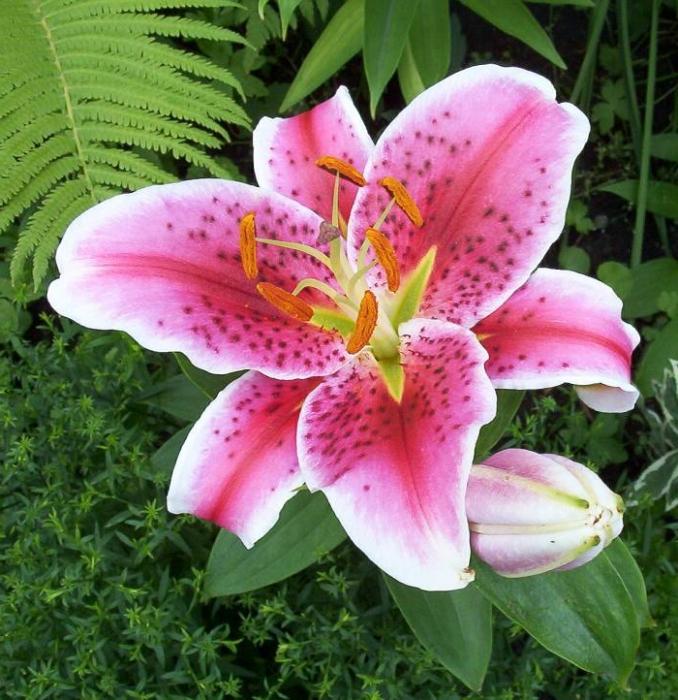

Many growers are new to the timing of when lilies are dug up. Gardening professionals recommend doing this 3-4 weeks after flowering, but not before.
If the lilies have faded, what to do with the bulbs, how to transplant them to another flower bed? If the transplant is done ahead of time, the flower may not take root or even die. The bulb must dry before planting, and the dead parts of the plant must also be separated. The root crop must be treated with a barely pink solution of potassium permanganate. This will help disinfect the bulb and protect it from infections. Then it is transplanted into a pre-dug flower bed.
Storing lily bulbs
Only a few can be left in the ground. Asian hybrid plants tolerate cold winters well, it is better to dig up tubular lilies, place them in a mixture of sand and peat, or in sawdust and store in a cellar until spring. You can also limit yourself to storing the bulbs in the refrigerator, but not in the freezer, in a bag of sand and peat, or in a sawdust substrate.
Shelter lily bulbs for the winter
Oriental varieties of lilies for the winter are covered with a layer of peat or foliage of trees. The best insulation for bulbs that will hibernate in the ground is a layer of snow. By spring, the compost layer is removed according to weather conditions.
Lilies are perennial bulbous plants of the Liliaceae family. The active growth of these flowers begins in spring. In May and June, lily shoots decorate flower beds and flower beds with their greenery. Flowers appear at the end of June. Lilies bloom for about a month. With the arrival of August, flowering gradually fades away. Having given all its strength to the formation of buds, the plant needs rest. However, this does not mean that the growing season is over and the lilies no longer need care and attention.
- Show all
Do I need to dig up lily bulbs
To answer this question, you need to take into account two nuances:
- variety of lilies;
- climatic characteristics of the region.
If the variety of lilies you grow was created specifically for your region, then the flowers can be left to winter in the open field without building a shelter. In central Russia, LA hybrids, OT hybrids and "Asians" winter well.
If you planted plants that are accustomed to living in milder climates in your flowerbed, then they can survive the winter if it is snowy and mild. For such lilies, the construction of a shelter is desirable. If this is not possible, it is better to dig up the bulbs.Then they will definitely live until next spring.
Bulbs of flowers, which are hybrids derived from varieties of American and Oriental plants, must be dug up. They can die in the conditions of the Russian winter, as they do not tolerate frost. Even if they manage to survive, they will not bloom next year. If you dig up the bulbs in the fall and plant them again in the spring, you will definitely wait for abundant and bright flowering.
Important! Once every 5-7 years, it is necessary to dig up any, even winter-hardy, varieties of lilies for transplanting them to a new place. If they grow in one place for a long time, they will become cramped due to the grown daughter bulbs.
Typical mistakes of novice florists
The main errors are associated with inappropriate storage conditions:
- At low storage temperatures, the setting of flower buds slows down. This can slow down the flowering process or even eliminate it.
- In low humidity, the bulbs quickly become unsuitable for planting as they dry out.
- At high humidity, the planting material becomes moldy and can rot.
- If the storage area is too warm, the bulbs will start to grow prematurely.
- During the winter, be sure to check the bulbs. If mold appears, you need to wipe the planting material with a damp cloth, sprinkle the affected area with a coal composition.
- When rot appears, it is removed with a knife, treating the cut points with a solution of brilliant green. If the bulbs are badly damaged, they are thrown away.
Timing
After flowering lilies, the stems of the plants are not cut, but carry out the following actions with them:
- remove seed pods (seed propagation is extremely rare by gardeners, since there are simpler and more effective methods);
- pinch the formed ovaries on the stems, since the buds will no longer have time to form by the end of summer and will unnecessarily deplete the bulb;
- leave the stems to dry naturally.
Important! At the end of the season, dried stems of plants are cut to the root. The full ripening of the bulb after flowering takes 1–1.5 months.
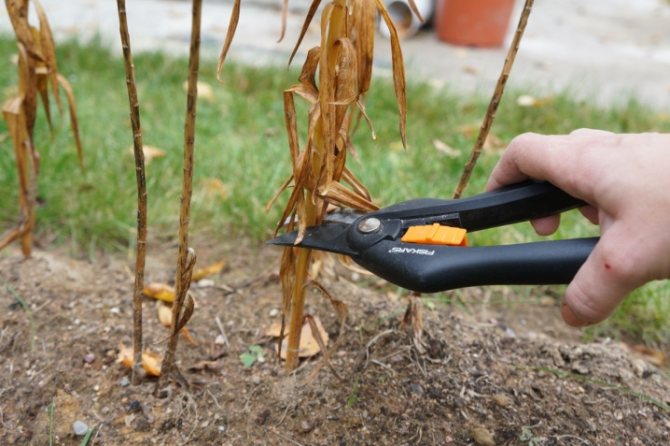

For winter storage, bulbs of heat-loving varieties of lilies are dug up in the fall. The digging time is determined by the state of the aboveground part of the plant, the stem at the base should be dry, which means that the bulb is fully ripe. For different varieties of plants, this moment occurs at different times, digging out lilies begins on August 15 and ends before September 10. Lilies imported from southern countries do not need to be dug up for the winter in areas with a temperate climate, for example, in the Moscow region, but in this case it is necessary to take care of their warming for the winter. Various materials at hand are used to cover the flower garden, namely:
- construction waste, sawdust;
- hay, straw;
- dry leaves;
- dried tops of vegetables.
Important! Heaters that can be blown away by the wind must be pressed down from above with boards or roofing felt. With the onset of winter, the area with flowers is covered with a thick layer of snow over the shelter.
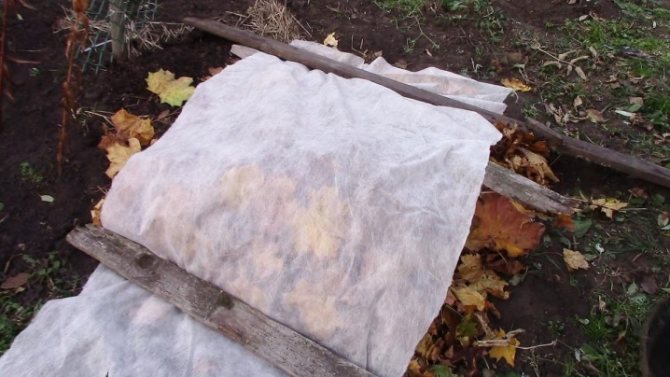

Lilies can remain in the soil for years, blooming every year. Plants are dug up only if excessive crowding begins to affect the quality of the flowers. Daughter bulbs with roots and stems are separated from the mother bulb, excess shoots are removed, and the desired specimens are seated again at a distance of 30 centimeters from each other. In order for young shoots to take root before frost, heat-loving lilies are divided and planted in mid-August, and frost-resistant plants - in early September.
Preparing lilies for planting
Before planting in a pot, lily bulbs are prepared:
- Carefully remove old dried roots.
- Hold for half an hour in a pink solution of potassium permanganate.
- If desired, soak for 12 hours in a solution of any growth stimulant.
You can buy soil for growing lilies at the store. Choose a seedling soil with a pH of 6 to 7. It contains the nutrients the plants need.
To prepare the soil yourself follows from humus and sod land. They are taken in equal proportions and a little ash is added. Such a mixture will have to be disinfected with a solution of potassium permanganate or Fitosorin.
Wintering in the beds
If the winter hardiness of the variety is good, you can leave the bulbs on the ground in the flowerbed. However, no varieties leave without shelter: our harsh winters can only survive on bulbs under protection. The best cover for planting material is a good layer of normal loose snow. To prevent the bulbs from being damaged by frost, the layer must be at least 10 cm.
However, snow does not always fall on time: sometimes frosts hit earlier. To avoid freezing of the onions, they are sprinkled with fallen leaves, peat or spruce branches in autumn. It is most profitable to use coniferous spruce branches, since slugs cannot hibernate under it.
In the spring, you need to clean the shelter on time. If this is done too early, the sprouts that have begun to hatch may be affected by recurrent frosts. And later removal of the shelter can lead to the fact that, due to a lack of light, the sprouts will turn out to be frail, weak.
Proper storage
Store adult bulbs in a cool, dark and ventilated place. An excellent storage option is an autumn planting in pots with soil, which also need to be kept in a cool room. But if both options are suitable for mature bulbs, then small bulbs are stored exclusively in the ground, since they are still very weak and dry out without soil. They must be planted no later than 7 days after digging up.
The soil for wintering should be predominantly sandy, and the size of the pot must be selected based on the size of the bulb. After planting, pots with seedlings should be placed in the basement, or a refrigerator - the main thing is that the air temperature is in the range of + 4-6 ° C. If the planting material will be stored without soil, it is necessary to dry the onions well, and then place them in a plastic bag and put them in a cool place. Before that, you can lightly sprinkle them with sand or.
Gardeners know that the life span of lily flowers lasts for 3 months of summer, starting in June, ending by early September. But what to do when the flowers of the plant have faded and left protruding green stems instead of luxurious flowers. The first step before the gardener is the task of trimming the stems, while cutting them off when they are completely dry. This will ensure their preparation for the winter period and further planting in the coming season.
How to choose storage space
The storage location is important for the safety of lilies. The temperature regime is important, which must be constant. Best of all, if the temperature is at the level of 0 ... + 4 ° С. Experienced growers do not recommend storing lily bulbs in the refrigerator, because there is not enough ventilation. As practice shows, such storage significantly reduces the stock of planting material.
It is most convenient to store lilies in a cellar or basement. They are ideal because they are easy to achieve the required temperature, ventilation and humidity. During the winter, it is necessary to take into account what the air temperature is outside in order to open or close the ventilation duct as necessary.
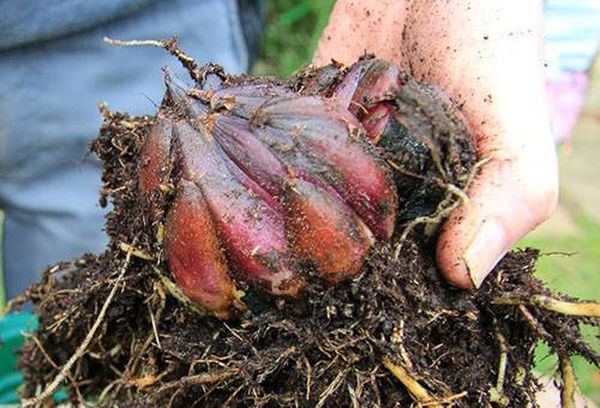

Do the bulbs need to be dug up?
Lily is a perennial bulbous herb that can grow in one place without transplanting for up to 6 years or more. The flower is propagated by separated daughter bulbs in late August or early September. Reproduction by baby bulbs and scales can be done at any time of the year. The following are the main factors that lead to digging up lilies every year:
- type of plant;
- climatic conditions;
- target orientation.
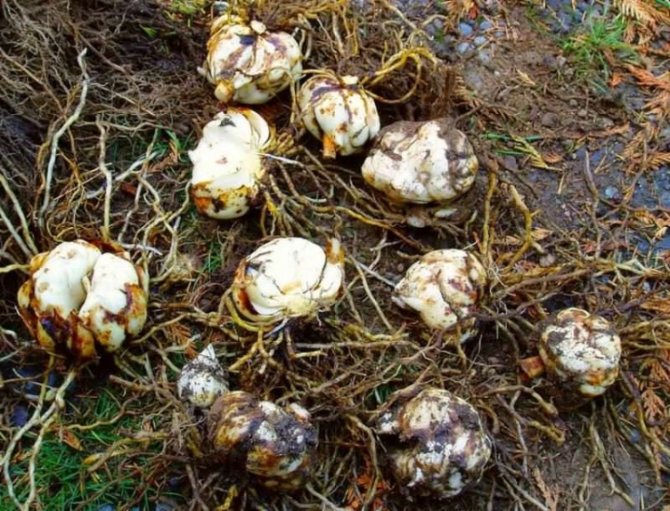

Each type of flower has its own characteristics.In the twentieth century, new species of frost-resistant lilies were introduced to the population, including hybrid plant varieties that opened up new standards of vitality and disease resistance. The most hardy and unpretentious are such types of lily hybrids as:
Important! The bulbs of these varieties are perfectly preserved in the winter in the ground under the snow when using conventional mulching.


Some types of lilies, including exotic ones, are not very hardy, but because of their beauty, many gardeners would like to see such flowers on their plots. Breeding lilies brought from southern countries to places with cold climates often gives a positive result, provided that the bulbs of these plant varieties must be dug up every year for the winter. These types include the following:
- white lilies;
- American hybrids;
- long-flowered hybrids;
- oriental hybrids.


Important! Timely measures taken to preserve the bulbs in winter will make it possible to avoid the risk of losing rare specimens.
Each climatic zone has its own flowers, which over the years have adapted to local weather conditions, this is called natural selection. When buying a lily of a new variety, you need to find out where the flower comes from. The right information will help the grower use the right methods for growing it. When growing flowers for sale, lilies are dug up every year to get new copies as quickly as possible. In such cases, they often resort to an artificial method of obtaining a large number of offspring - the bottom of the bulb is cut out or deep cuts are made on it, then a lot of children are formed.
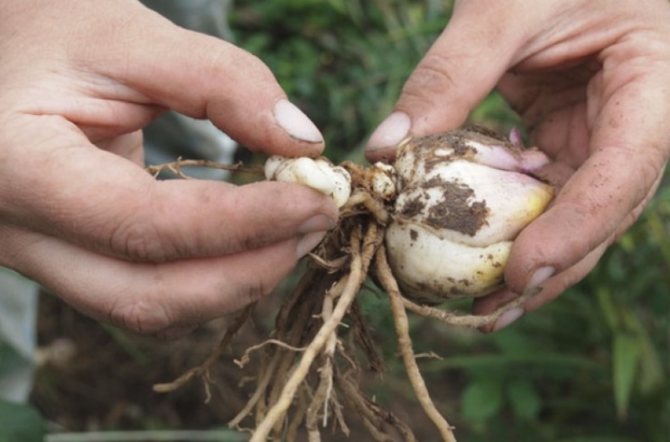

Proper preparation


The key to high-quality preservation is the correct preparation of planting material in the fall. After the plant has faded, there is no need to cut off the inflorescences and stems, it is necessary to let them dry naturally. The plant needs about 1.5 months to rest.
On a note!
Many people leave the bulbs in the ground for the winter, but for more reliable preservation in cold winters, it is better to dig them up for storage.
Dug out the bulbs at the onset of frost. The stems are cut first, leaving about 5 cm above the ground. Then separate the circular gap with a pitchfork so as not to damage the roots. Then the bulbs are carefully removed from the soil.


You may be interested in:
Lilies in the fall: care and preparation for winter shelter, pruning Lilies are perennial, demanding flowers. For bulbous plants to grow well and always bloom, it is necessary ... Read more ...
The bulbs are washed in water and sent to dry in a cool, dark place. Before storage, each is inspected for signs of decay or disease. After drying (about a day), the lilies are treated with fungicidal powder, placed in paper bags or wrapped in newspaper. The prepared material is stored using cardboard boxes, where there are holes for ventilation. Each bulb is shifted with sawdust or moss. For storage space, you can choose a basement, garage or balcony.

